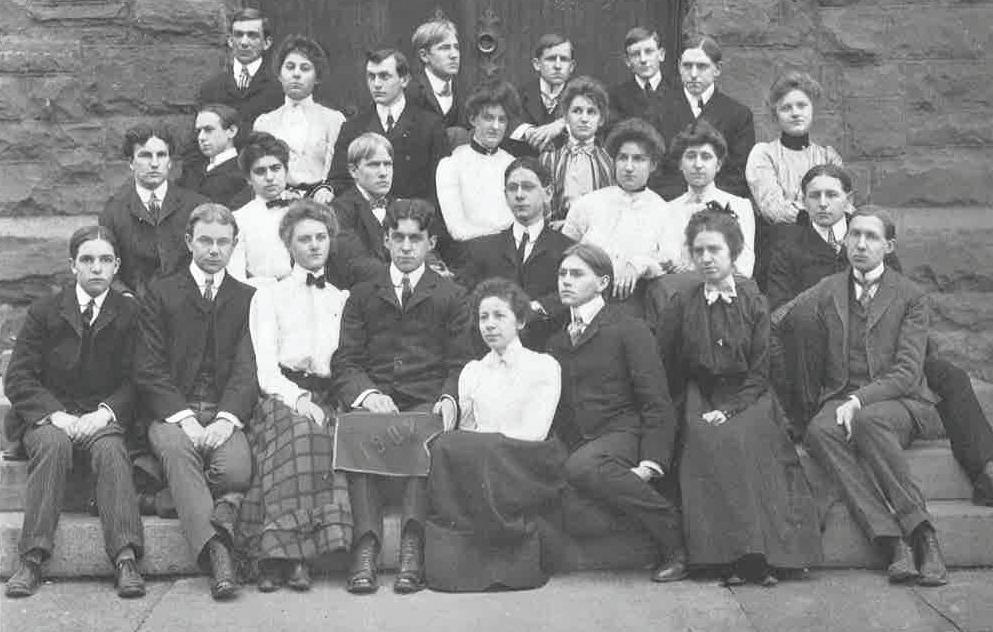

A LOOK BACK



A LOOK BACK
By Kevin Rea
We have very strong traditions at Wyoming Seminary. In the summer of 2015, the summer before I arrived, I enjoyed the constant companionship of Leroy Bugbee’s intimidatingly voluminous history of the first 100 years of Wyoming Seminary. I read it everywhere — in the car, on the couch, on the porch and even at the beach! Our school’s deepest traditions appear in every chapter of that impressive tome. As an English teacher, however, I have always enjoyed uncovering implicit themes. What struck me most in reading the history of Sem’s centenary (and what remains with me five years later) is that a vital part of the “Sem story” arrives in the form of innovation. Some institutions tout their history in ways that convey the distance of the past, a desire to preserve things “the way they have been.”
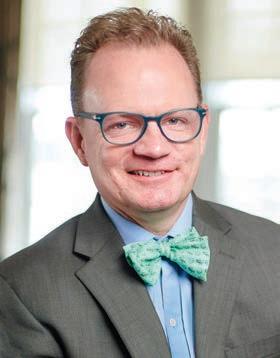
When contemplate our history, I see a lively one of embracing evolving, contemporary needs in education with enthusiasm, of making the most of our location in northeast Pennsylvania, of pressing forward, of embedding the architecture of innovation in our plans to preserve the ideals of the true, the beautiful and the good.
I hope you will enjoy reading about Sem’s inspiring history of innovation in these pages. As one of our nation’s oldest coeducational boarding schools, we welcomed students from a global background as early as the 19th century. Our founding traditions of global awareness and equity thrive in our contemporary deployment of Narrative 4 story circles and our role as a Global Member School in Round Square. We launched a school of business under the leadership of Dr. Levi Sprague, whose traditions live on today in the teaching of economics and STEM. What once was the Senior Oration is now the tradition of iPresent and the eighthgrade speech. While still maintaining a historically strong Latin language program, we teach Mandarin and offer travel exchanges to Shanghai, China as part of our engagement with the World’s Leading Schools Association. From the early sports of baseball and football we have evolved to offer championship field hockey, rowing and Olympic-level girls wrestling.
As we celebrate Sem in 2019, we enjoy a position of strength in the contemporary independent school world. We continue to focus on preserving our ability to innovate from a background of historic tradition. While being 175 years young, we continue to move forward by doing what we have always done, supporting our people and our programs with a strong vision embedded in the true, the beautiful and the good.
Enjoy this impressive chronicle of our school’s deepest themes!
LEADERSHIP
Chair:
William E. Sordoni ’93
Vice Chair:
John Dowd
Treasurer:
Anthony L. Berger ‘73
Secretary:
Marjorie Henry Marquart ’78
TRUSTEES
Lisa Baker
Amy Valli Bennett ‘94
Frederick "Fritz"
Bittenbender '89
Matthew Bruno ‘94
Charles J. Bufalino, III ‘78
Leslie Turrell Bullock ’63
Frank C. Carlucci, IV ’81
Jody Cordaro
Dorothy Darling ‘68
Robert C. Friedman ‘73
Bruce E. Gover ‘98
Gerald Gunster ‘85
David Hourigan ‘71
Richard M. Hughes III ’79
Stephen B. Killian ’66
Joseph E. Kluger ‘82
Mary Lopatto ‘72
Jeffrey Metz ‘88
Scott Meuser
Janet Murray ‘76
Charles Parkhurst ’79
Cornelia Conyngham Romanowski ‘75
Stephen J. Rosenthal ‘93
Robert Tamburro ’91
Lewis Thayne ‘67
Nicole Santo Yochum ‘03
TRUSTEES EX-OFFICIO
Mary Louise Decker-Fenster
Tara Mugford Wilson '88
Kevin Rea
TRUSTEES EMERITI
Richard Goldberg ‘55
Rev. Charles F. Gommer
Leonard Insalaco
Sue Kline Kluger ’55
Arthur W. Sherwood ’56
Robert H. Smith ’56
LIFE TRUSTEES
Barbara Fassett Oski Beane ’53
Harold C. Buckingham, Jr. ’48
Rev. Wesley R. Crompton ’43
Harry F. Lee ’53
John F. Magagna ’52
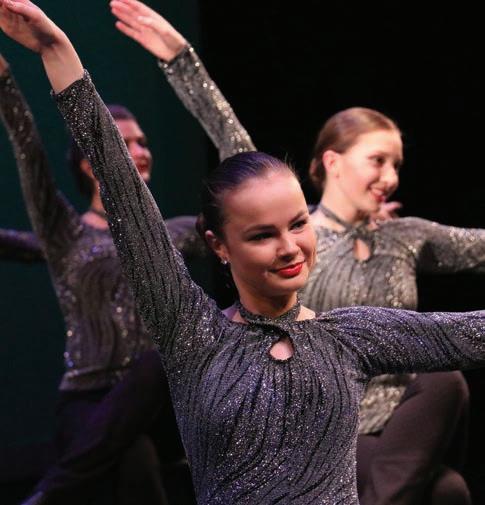
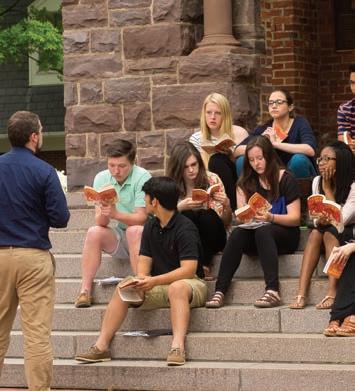
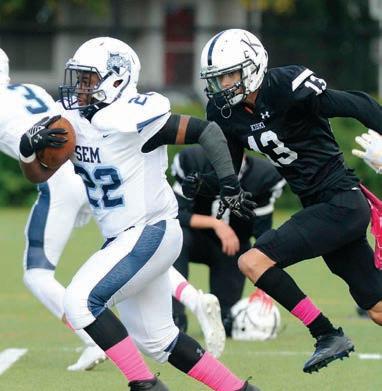
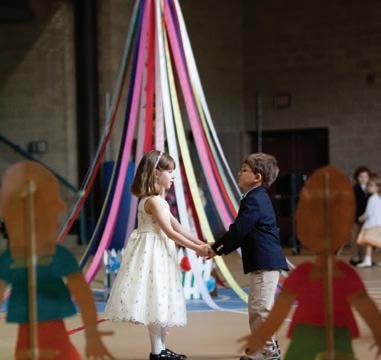
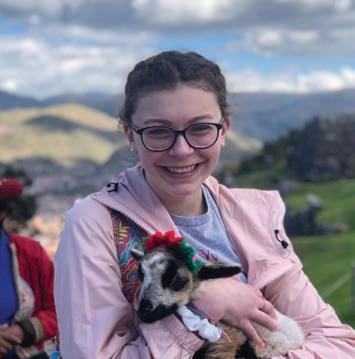
Wyoming Seminary Journal
Anniversary Issue, Summer 2019
The Journal is regularly published by Wyoming Seminary and is mailed free of charge to its alumni, parents and friends. We welcome story ideas and encourage letters to the editor.
Please send correspondence to:
Jill Snowdon jsnowdon@wyomingseminary.org 570-270-2195
Jill Snowdon
Wyoming Seminary 201 North Sprague Avenue Kingston, PA 18704
Editor-in-Chief
Jill Snowdon
Editorial Staff
Liz Hibbard ’69
John Shafer ‘71
Gail Smallwood
Graphic Design
Shannon Zimmerman
Printing
Llewellyn & McKane, Inc.
Photography Fonash Studios
Josiah Lewis Photography
The Citizens' Voice
Wyoming Seminary Staff
Special Contributors
Logan Chace
Jack Eidam
Mary Frances Donley Forcier '79
Randy Granger
Jay Harvey '80
Dawn Leas
Clark Switzer
Connect with Us
Facebook.com/wyomingseminary
Twitter.com/wyomingseminary
Instagram.com/wyomingseminary
Snapchat username: wyomingseminary
By Jack Eidam
“The True, the Beautiful and the Good:” For decades and for many alumni, those words ARE Wyoming Seminary. One would assume they were spoken at the school’s founding ceremony in September 1844, and they may have been. However, the first evidence of Sem’s adaptation of the phrase came a quarter century later, according to historian Leroy Bugbee, author of the school’s centennial history.
In the 29th annual Catalogue of Wyoming Seminary and Commercial College of 1872-73, “The True, the Beauti ful, the Good” appeared in print for the first time.
The first two-and-a-half decades of Sem’s history were unsettled at best. In the 1870s it was time to reflect stability. The school needed to define its identity to reflect extraordinary qualities of academic inquiry, moral character development and loyal school spirit.
Official school colors – navy blue and white - were chosen to represent the school consistently on banners, posters, class rings, athletic uniforms, and the school flag. Prizes were created bringing public recogni tion to the accomplishments of student orators and lifting the profile of Sem’s commitment to scholarly endeavor.
be enhanced if the motto appeared on the school seal in one of the classic languages. In the debate between Greek or Latin, Latin won. Thus, the seal of today reads Verum –Pulchrum – Bonum.
For centuries, these three spheres of knowledge have inspired intellectual dialogue. Today, renowned author, Harvard professor, educational psychologist and distinguished Sem alumnus, HOWARD GARDNER ’61, embraced this ancient refrain in an interview:
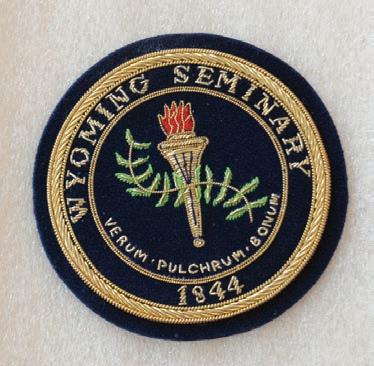
“..the lasting values summarized in the triad: truth, beauty, and goodness. When I talk about truth, I’m talking about science but also folk knowledge; when I talk about beauty, I’m talking about the arts, but it could be nature as well; when I’m talking about goodness and evil I’m talking about morality.”
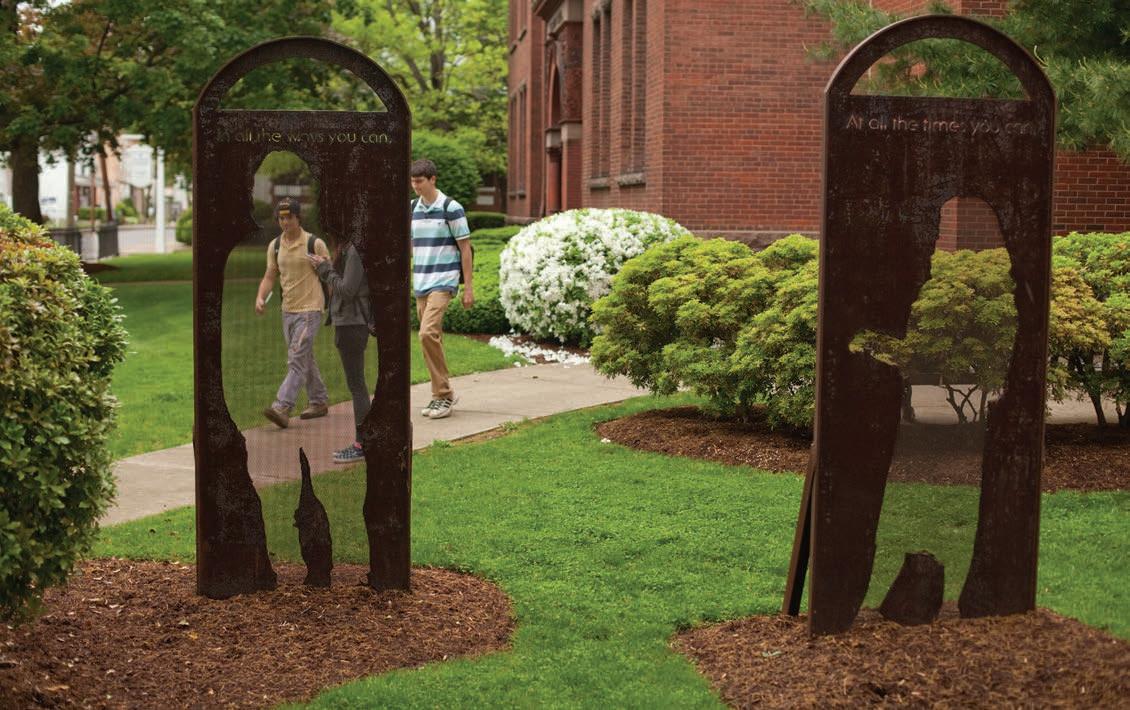
A tag line was needed along with an institution’s name to affirm the faculty’s devotion to lofty thinking blended with respected, fresh pedagogy. Followers of the French academic Victor Cousin favored his lectures on the three orbs into which all knowledge can be ordered. Thus, “The True, The Beautiful, The Good” was inserted on the flyleaf of that 1872-73 catalogue.
Apparently, even though the phrase had been commonly adopted in some measure through the turn of the century, it was not until the 1944 Centennial year that it became the official Wyoming Seminary motto.
In the 1970s, school leaders decided Sem’s image would
Prefacing his prayer at a recent Baccalaureate service, Sem trustee Rev. Charles Gommer made the following observations about Sem’s institutional character. He suggested, “The religious foundations of our school are so often understated. Rather, they are quietly affirmed… they are lived out in the professional and private lives and relationships of our faculty, staff, students, and leadership of the school. And the centerpiece of those religious foundations, expressed in the Christian, Jewish, Moslem and Asian faiths is always the same. There exists a transcendent power, greater than ourselves, to whom we are accountable for the way we live out our lives.
“That is a significant part of who we are at Seminary and what we hope our students will come to recognize as an essential element in the development of a morally and ethically centered life. It is a life, lived in pursuit of all that is TRUE and all that is BEAUTIFUL and all that is GOOD.”
President Kevin Rea, writing in the Spring 2018 edition of the Wyoming Seminary Journal, summarizes it this way: “Wyoming Seminary’s highest aspirations reside in the true, the beautiful and the good, which lift us to achieve tremendous things together.”
Wyoming Seminary’s highest aspirations reside in the true, the beautiful and the good, which lift us to achieve tremendous things together
“
By Jack Eidam
Were it not for the Methodist Episcopal Church of the mid-1800s, Wyoming Seminary would not exist as we know it today. In the rural territories of Northeastern Pennsylvania and upstate New York, religion had become an important thread in the fabric of life.
“Methodism,” writes Sem historian Leroy Bugbee, “was an aggressive, missionary faith, adjustable to frontier conditions and to the rural areas where members lived in widely scattered and thinly populated communities.” Small Methodist societies would meet regularly in homes. Circuit riders, preachers on horseback, would ride regular routes among the villages to hold class meetings and preach the Gospel.
The Rev. Dr. George Peck was appointed by the Oneida Annual Conference to ride the circuit and serve the growing Christian population of the Wyoming Valley. At what is now the Forty Fort Meeting House, he delivered a sermon in October 1839 advocating for a “seminary of learning.”
In March, 1843 the Oneida Conference voted to support the founding of the school and appointed its first Board of Trustees. The Church was critical in those early days by providing both financial and human resources. Laymen Thomas Myers, his brother Madison, Ziba Bennett and William Swetland were tireless and generous in their support. Funds were raised
“DO ALL THE GOOD YOU CAN, BY ALL THE MEANS YOU CAN, IN ALL THE WAYS YOU CAN, IN ALL THE PLACES YOU CAN, AT ALL THE TIMES YOU CAN, TO ALL THE PEOPLE YOU CAN, AS LONG AS EVER YOU CAN.”
- John Wesley
from loyal Methodists, and educators were identified to lead and teach within the infant institution.
Reuben Nelson, a one-armed farmer turned self-taught educator and Methodist preacher, was appointed the first principal. He arrived in the summer of 1844 to find the original building under construction. It was his firm commitment to the values of Methodism that guided the development of courses and selection of teachers. His faculty were held to an exceptionally high standard of moral leadership and academic acumen. Together they shaped the
thinking and values of future community leaders.
For the first 150 years, the people of the Methodist Church sent their children to Sem, and they nurtured the school through varied crises. Its principals (presidents) were churchmen; many were ordained Methodist clergy.
In the 1970s, legislative challenges influenced the relationship between the Methodist Church and the school. First, the Pennsylvania legislature defined clearly what constituted institutions as sectarian or non-sectarian, and funding for sectarian schools. Second, litigation brought against individual church-related institutions threatened liability throughout denominational administrative structures to the national level, placing entire denominations at risk. Thus, the nation-wide General Conference of the United Methodist Church and its affiliated institutions, including Sem, needed to draw clear lines of independent, unconnected governance.
Still, the traditions of United Methodist Church shape the sense of mission and core values of Wyoming Seminary even today. Daily, students walk alongside the iron-cast sculpture reflecting the words of Methodism’s founder, John Wesley: “Do all the good you can, by all the means you can, in all the ways you can, in all the places you can, at all the times you can, to all the people you can, as long as ever you can.”
It’s often been suggested that Wyoming Seminary is “the oldest continuously coeducational boarding school in the United States.” If that’s true, it’s quite a distinction. But is it?
By Mary Frances Donley Forcier '79
Coeducation and Sem’s Methodist roots
From the vantage point of 2019, the religious landscape of 1840s America seems bewildering. So many denominations. So much passion. What did it all mean?
The “Second Great Awakening” – a surge of religious enthusiasm marked by tent meetings and revival services featuring an emotional, public call to faith – had swept the young country beginning in the 1780s. Methodism, which had developed in England in the 1730s, was ideally suited to the American frontier.
John Wesley, its founder, embraced the doctrine of personal salvation and rejected the man-made boundaries of the Church of England, which proscribed who could teach and preach. From the beginning, Methodism was a movement for and by the “common people:" the miners and millworkers of newly industrialized England.
In 1746, Wesley enlarged a school at Bristol, which he had started for the children of coal miners, developing Kingswood School largely to educate the sons and daughters of Methodist ministers. Wesley sought to bring salvation to all: women and men equally, referring to them as “brothers and sisters.” He allowed women to preach in England as early as 1771, and encouraged women’s roles as visitors to those imprisoned or ill.
In America, Wesley’s methods were adapted to a new world. Itinerant Methodist preachers, called “circuit riders,” traveled on horseback to serve their congregations, which were scattered across rural circuits of 200 to 600 miles. It would take four to six weeks for the preacher to cover his “circuit,” ministering to his flock in meet-
ing houses, on campgrounds, in homes, and in tiny churches.
His emphasis on education found fertile ground in the rocky soil of New England. The founding of the Wesleyan Academy in 1817 in Newmarket, N.H., marked the first Methodist coeducational boarding school in the United States.
“The Methodists of that day had a laudable desire to take a hand in the great educational system through which their children were to pass,” noted the Rev. David Sherman in his 1893 history of the Wesleyan Academy. “As other sects were engaged in higher education, the Methodists could not retain respect for themselves if they refrained from the work. They wished to do whatever was demanded by their position, as one of the religious organizations of the country; and it certainly seemed to be a plain demand that they should take steps to found institutions for the training of those committed to their care.”
Wesley’s emphasis on education for boys and girls extended to this new American Methodist school. As Rev. Sherman notes, “The plan of education adopted by the Methodists departed, in some particulars, from the ideal system of New England. Co-education was in the first draft. The opposite system, followed at Exeter, Andover, Mount Holyoke and other places, contains a trace of the oriental and medieval doctrine of the inferiority of woman.
"The Methodists broke with the past, and elevated woman to the platform of advantage accorded man in the church and school. The work for women by John Wesley has been continued in the schools of Methodism. In this respect, the first foundation at Newmarket was an object lesson. In the privileges and honors of the institution, woman stood beside man, and the custom so happily inaugurated there
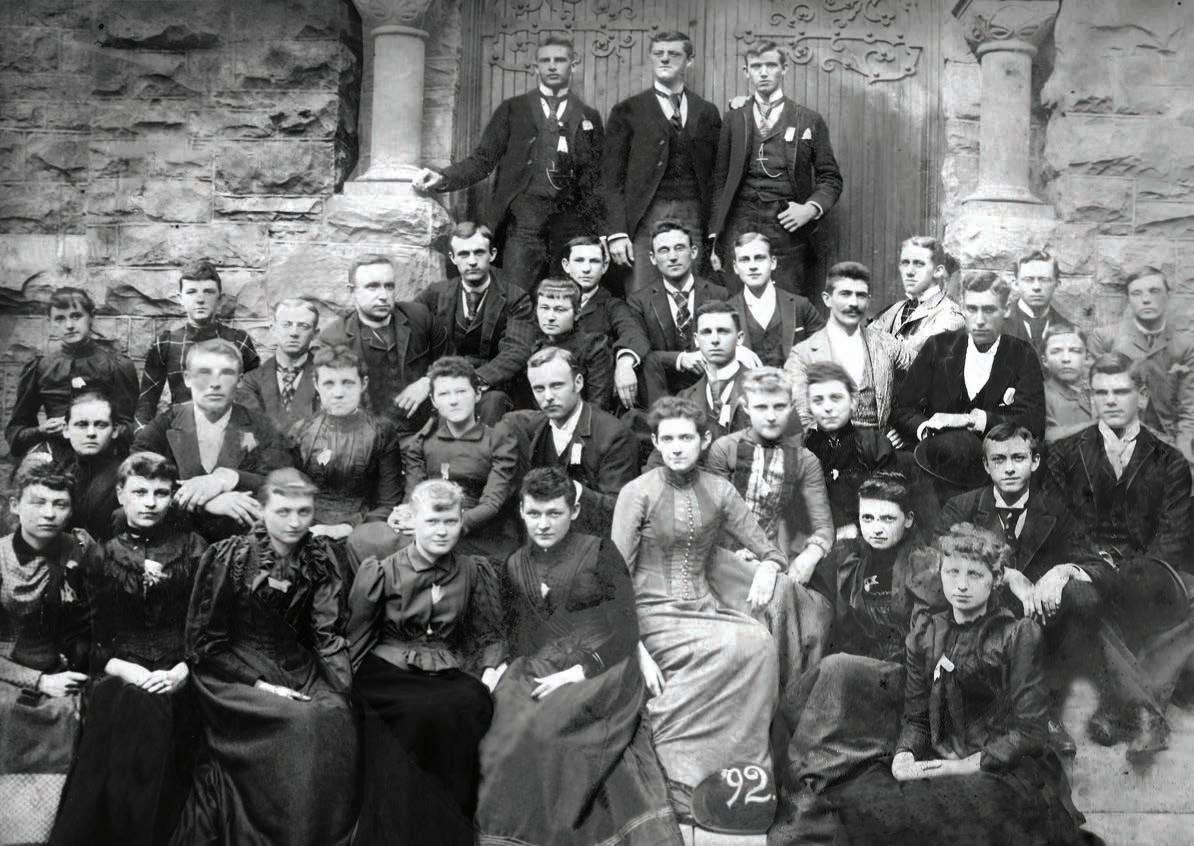
has continued in most of our academic institutions, and is fast making way in our colleges.”
The Wesleyan Academy was to serve as a model for other Methodist schools. But its success in New Hampshire was shortlived. What happened to the Academy?
“The patronizing territory was too narrow. Connecticut and Vermont, the most populous Methodist sections at the time in New England, were too far away to furnish students, or to feel a deep interest in the Academy. In the strip along the seaboard, on which the institution must depend, there were hardly more than two thousand Methodists. In view of this fact, the wonder is not that the Academy failed, but rather how it was able to begin. It was a happy spasm of Methodist sentiment, which has exerted an enduring as well as happy influence on the denomination.”
After declining enrollment, it moved to Wilbraham, Mass. in 1825, where, as Wilbraham Wesleyan Academy, it continued as a coeducational boarding school for
many years — although, like fellow Methodist school Tilton Academy, it went through a “boys-only” period. Maine Wesleyan Academy — now Kents Hill School — more closely resembles Sem. It opened in the spring of 1824 with a class of young men and women, and has been continuously coeducational since. Between 1790 and 1820, a steady stream of migrants left New England for new opportunities. “The agricultural intervales and valleys in the midst of the sterile hills of New England had been overcome in their historic economic life and prosperity by the competition and attractions of the cheap and fertile lands of the West, — new and vaster intervales for the moving population — and by the pull of the rising cities, such as Boston and New York, upon the more enterprising and ambitious of the farmers' boys,” said Frederick J. Turner, writing for the American Antiquarian Society in 1919. “The canals and then the railroads made the competition keener and the way to the West easier.”
A booming economy, the 1825 opening of the Erie Canal, and a constant stream of western migrants made upstate and
classes. It was not always easy to control the social intercourse of the sexes,” recalled William Reddy in his 1875 history of the school.
“There were many flirtations, and not a few attachments and engagements, some of which terminated in marriage. So far as have learned, the marriages which resulted from these engagements at school have been happy. Of course there were disappointments, jealousies, and heart-burning; but, on the whole, what with walking, driving, and sailing on the lake, there was no lack of recreation; and life at Cazenovia was very pleasant."
Despite this “very pleasant” life on the lake, the Cazenovia Seminary did not remain an idyllic coeducational boarding school, becoming the Cazenovia Junior College for Women in 1942 after the Depression took a major toll on enrollment. Another Methodist school, Genesee Wesleyan Seminary, was founded in 1831, in Lima, N.Y. (30 miles south of Rochester). Its companion college, Genesee College, left Lima to head east to Syracuse in 1870; it grew into what is now Syracuse University. The seminary remained and in 1932 celebrated its centennial as "the oldest co-educational institution in the country." Then in 1941, after 109 years, the Genesee Wesleyan Seminary closed.
Seminary fever hits the Wyoming Valley
western New York a vigorous center of intellectual, technological and religious life in the 1830s and 1840s.
It is difficult today to imagine the powerful combination of forces — industrialization, immigration, social reform, women’s rights, religious fervor, and abolitionism – in and around Central and Western New York.
For many progressive reformers in the region, educating women and men side by side was important to realizing the ideals of the new republic. Together, educated parents would civilize the new western territories and build a world for their children based on progressive principles and social justice.
To develop these ideals, Methodist schools — or “seminaries” — were springing up throughout New York State. At Cazenovia, 20 miles southeast of Syracuse, the Cazenovia Seminary was established in 1825 on the Wesleyan model.
"The young ladies lived in a separate building, but both sexes took their meals at the same tables, pursued substantially the same studies, and recited in the same
After the War of 1812 opened the way for Pennsylvania anthracite coal, the development of major Pennsylvania canals provided a way to get this valuable commodity to urban markets, where it was used for domestic heating and cooking, and fueled small businesses such as blacksmiths, brewers, bakers, and manufacturers. At the same time, railroads brought industrial prosperity to the shores of the Susquehanna.
In the 1840s, the Wyoming Valley, too, caught the “seminary fever.” In 1843, the Oneida Conference of the Methodist Episcopal Church sought to establish a seminary in rapidly growing “Northern Pennsylvania.” Established as a coeducational venture from the start, Wyoming Seminary has been continuously boarding and coeducational since 1844.
That’s not to say there weren’t challenges. In fact, they were the same challenges to confront other Methodist boarding schools.
“Muscular Christianity” and the modern boarding school
After the Civil War, new expressions of masculinity and femininity, coupled with the rise of new, “elite” boarding and day
schools in concert with industrial fortunes, led to declining support for the pious, Wesleyan-style seminaries of the antebellum era.
The most famous anti-coeducational treatise was Dr. Edward H. Clarke's 1873 book "Sex in Education or A Fair Chance for the Girls" in which he suggested that higher education for girls risked their sterility, their mental health, and the future of the nation.
“Boys must study and work in a boy's way, and girls in a girl's way. They may study the same books, and attain an equal result, but should not follow the same method. Mary can master Virgil and Euclid as well as George; but both will be dwarfed, — defrauded of their rightful attainment, — if both are confined to the same methods.”
In the Wyoming Valley, Wilkes-Barre Academy was founded in 1807 as a modern preparatory school for boys, designed to ready the sons of the new industrial leaders of the region for their place in business and professional life. “Our Academy,” said an 1881 advertisement, “is not one of those simple, easy, goody-goody institutions advertised as being especially under the supervision of retired clergymen, who, it has unfortunately been discovered, have always paid more attention to creeds than to classics..:”
The late 19th century also brought the rise of the elite boarding school, also positioned to develop “manly” leaders for the new era. Modeled after the English “public” school, these schools developed a culture based on “muscular Christianity,” focused on vigorous exercise and spartan living.
The “St. Grottlesex” schools — often what flashes in one’s head when you say “boarding school”— are characterized by their location (New England and Mid-Atlantic), their pre-1900 founding dates, their significant endowments, and their selectivity. Largely single-sex until the 1970s, these schools in many ways stood in contrast to the coeducational, middle-class culture of early Methodist academies and seminaries.
Dedicated to the principles of equality, simplicity, community and
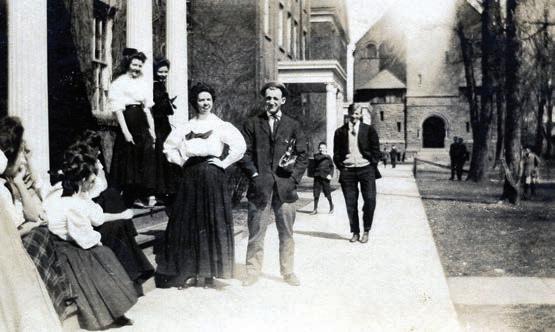
service — and closer to John Wesley’s ideal — Quaker boarding schools have quietly flourished for more than two centuries. Westtown School in West Chester, Pennsylvania, first welcomed students in May 1799, making it, in fact, the oldest continuously coeducational boarding school in the country.
While Sem has adapted to change by consciously seizing new opportunities, Quaker schools have held fast to their unique culture and ethos. Westtown, for example, only opened its doors to non-Quakers in 1933.
The Wesleyan model of men and women learning side by side — echoed in many ways by our Quaker colleagues — has served Sem and its students well since 1844.
Wyoming Seminary is in rare company: along with several of its Methodist and Quaker counterparts, it has survived and thrived as a coeducational boarding school through industrialization, changing gender roles, depression, wars and globalization.
We might not be the oldest continuously coeducational boarding school in the country. But it’s been quite a journey.
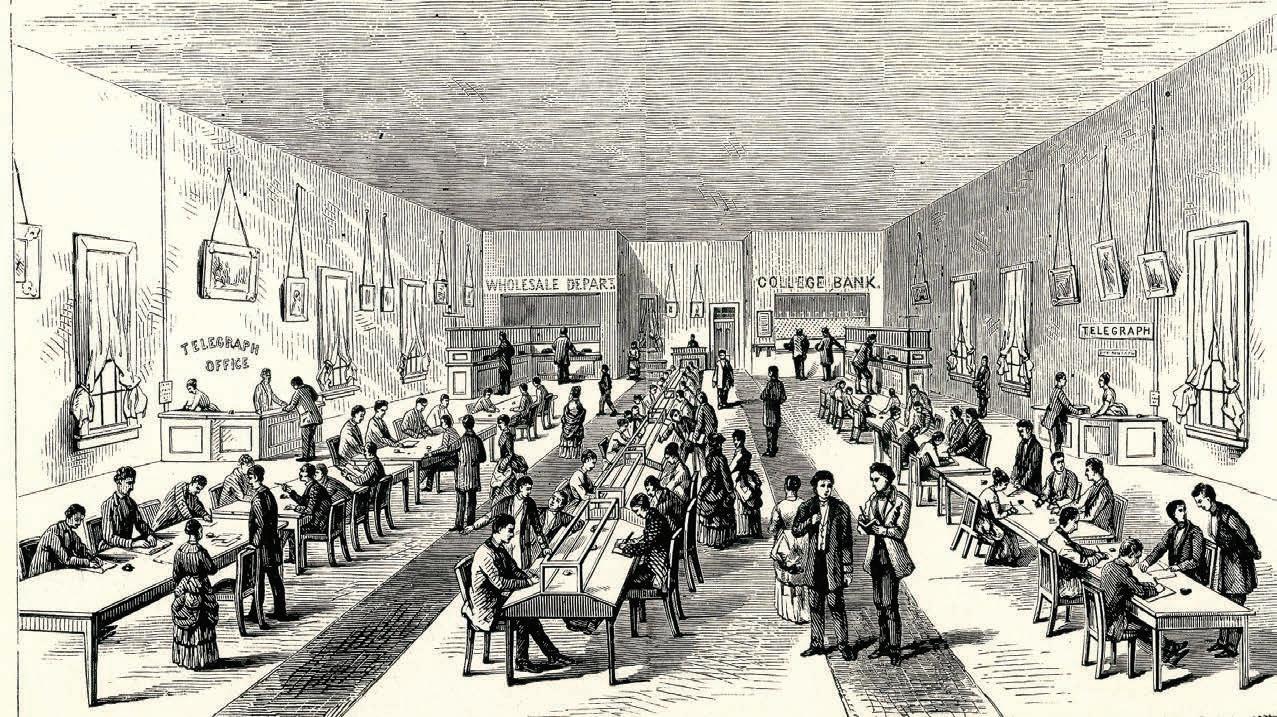

By Jack Eidam
The
Wesleyan model of men and women learning side by side has served Sem and its students well since 1844

In 1863, as the Civil War raged in southern Pennsylvania, Reuben Nelson resigned as Wyoming Seminary principal to preach the Gospel, traveling on horseback as a Methodist circuit rider. Less than a year later, the Sem Board of Trustees appealed to Nelson to return as principal, and he agreed under certain conditions. Among them, the Board agreed to open a commercial division preparing young people for careers in business. With the Board’s blessing, Reuben Nelson began his second term as principal and hired his former student Winfield S. Smythe, newly graduated from Wesleyan University, to teach the first business course.
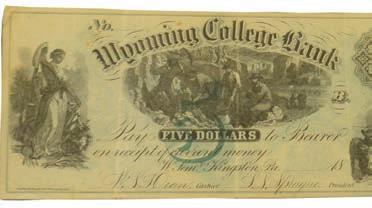

ed courses in accounting, bookkeeping, business spelling, grammar, stenography, telegraphy and penmanship. Commercial studies as a discipline was new, demanding freshly written teaching materials. The Sem archives hold as many as eight of Sprague’s published textbooks.
Willis Dean, who eventually succeeded Sprague as the department principal, joined the faculty in 1875 to teach penmanship. In tribute to the lasting impact he brought during his 67-year career, in 1931 Sem Trustees renamed the Wyoming College of Business the Dean School of Business. In addition to Dean, other notable faculty include Welsey A. Kuhn, Ernest E. Quay, MARY KEENLY ICHTER'24 and SARAH BARR '34
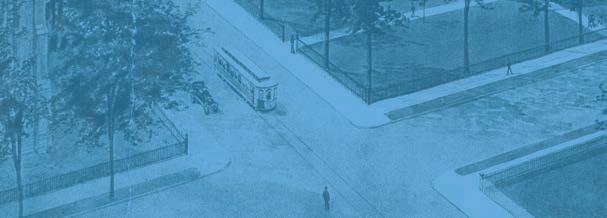
A few years later a young 21-year-old LEVI L. SPRAGUE 1867 enrolled for academic studies, aspiring to prepare for university studies in law. Nelson noticed his talent for teaching and offered him free tuition if he would agree to teach, and in this manner, Sprague’s more than 70-year Sem career began.
By 1867, he was named principal of the new Commercial College, later named the College of Business. For 15 years, he led the business division and developed a curriculum that includ-
For decades, the Wyoming Seminary business division was the premier institution for commercial education in Northeastern Pennsylvania, providing merchants, banks, institutions and varied businesses with highly skilled employees. It was at first located on the fourth floor of what was then Commercial Hall (now Fleck Hall) where the most up-to-date facilities were provided — bank teller stations, telegraph equipment, stenograph apparatus, etc. In 1894, it was relocated to the third floor of the new Nesbitt Hall where it stayed until its waning days, approximately 100 years after its founding.
Sem’s resilence in the face of difficulties
By Jack Eidam
Alook in Wyoming Seminary’s rearview mirror reveals countless celebrations — commencements, baccalaureates, championships among countless victories, magical performances and exhibits in the arts, debates, publications …. the list goes on. One cannot look at the 175 years, however, without also celebrating this old school’s resilience to the troubled times it encountered. Leroy Bugbee captured in detail the many economic downturns through which trustees, teachers and church people made sacrifices to “keep school.” That was first Principal Reuben Nelson’s refrain for each of the hardships he encountered — two fires, debt, disease, war, etc.
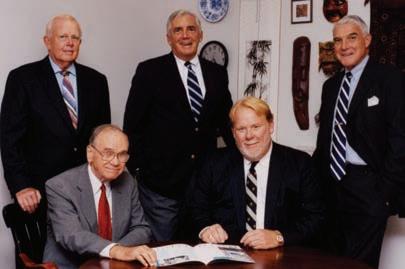
Considering that the people of Wyoming Seminary persevered through the Civil War, two World Wars, the Korean War, the Vietnam War, floods, fires, economic turmoil and the untimely death of significant leaders, Wyoming Seminary testifies to the strong will and firm commitment of men and women devoted to “keeping school.”
While the lows and the highs of the first 100 years are well reviewed in Bugbee’s Centennial History, the resilience of the last 75 years reveals remarkable strength and steadfast perseverance through stressful modern times. While the June Tropical Storm Agnes Flood of 1972 will long be remembered as having filled the basements and first floors of every building on the Upper School campus, immense tribute
for the amazing recovery (opening school just one week late) belongs to the leadership of President Wallace Stettler and trustee leaders like Richard Pearsall, FRANK HENRY ’50, Tony Grosek and A. HARDEN COON 1914 who powered through disastrous odds with positive thinking. Armies of faculty, alumni and volunteers also responded to the call of leadership to accomplish the unbelievable.
When the economy is strong, we may forget the tough decisions that must be made imposing sacrifice in programming and personal benefits. Certainly, Sem’s modern leadership has navigated the troubled waters of sub-prime mortgages, the crash of 1987, the Asian economic crisis of 1997 and the global downturn of 2008-2009. Through it all, strong leadership has always stepped forward to focus on the future. Even through the untimely deaths of three visionary board chairs within a short period — GEORGE SORDONI ‘64, RUSTY FLACK ‘72 and JACK MUELLER ‘52 — strong leadership led the way.
The Flood of 1972 served as a turning point for this old school, reviving a fervency that generated immense progress. The Seminary family came together. Seven new additions or stand-alone buildings have been constructed along with the installation of fresh artificial turf fields. Widespread renovation and renewal has taken place across both the Lower and Upper School campuses. Successors to the champions of yesterday — Bugbee, Brown, Abbott, Alcott, Atwood, Berger, Roberts, Parker, Foster — include giants of the 21st Century — Moriarity, Hopkins, Slaff, Ris, Kersey, Lull, Nageli, Harvey, Swanson, Klassner, Switzer, Vaida, and more.
Yes. Wyoming Seminary has persevered through the highs and lows of almost two centuries. It has demonstrated its institutional strength of character only because those who have led and those who have taught have inspired students and alumni to honor truth, respect beauty and do good in this world. Founder Reuben Nelson would be pleased that for 175 years we have been “keeping school.”

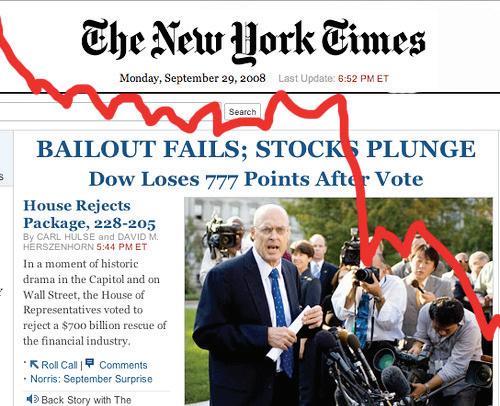
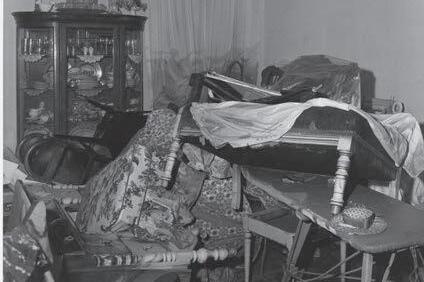
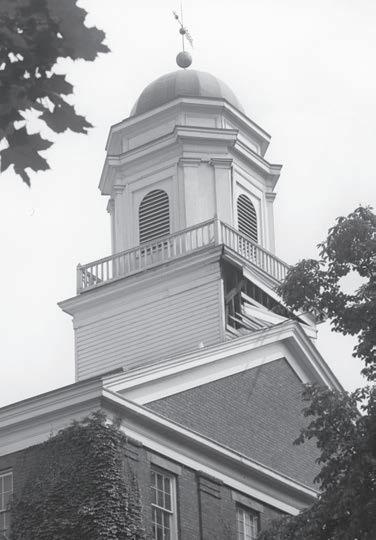

Flood Recovery General Contractor and Trustee Tony Grosek
a
into Carpenter Gymnasium to remove the warped basketball court; The cupola over Fleck Hall after a 1972 lightning strike; President Wallce F. Stettler and Bishop J. Gordon Howard observe a pile of discarded books from the Bennett Library following the 1972 flood; Disheveled furnishings in Swetland Parlors following the flood of 1972.
By Gail Smallwood
Wyoming Seminary’s vibrant arts programs have a long, rich history, beginning at the school’s founding. Whether it was learning to appreciate the beauty of the human singing voice, or observing how fine art can uplift the spirit, or meditating on Methodist hymns played on the school organ during chapel: the visual arts, instrumental and vocal music, and theater have been integral aspects of a Sem education for 175 years. Since 1979, the art of dance has been woven seamlessly into the school’s highly-regarded arts program. And in testimony to the remarkable quality of the school’s arts faculty, you will find Sem alumni artists, musicians and actors reaching the highest levels of performance in their fields.

How important have the visual arts been at Wyoming Seminary over the years?
best sustained work throughout their Sem careers.

So important that among the very first courses taught, beginning in 1844, were drawing and painting classes offered by Sem President Reuben Nelson’s wife, Jane Nelson. Students developed their eye for form, color and texture under her tutelage. Jennie Sprague, wife of Sem’s fourth president Dr. Levi Sprague, also taught art in classrooms located on the first floor of Nesbitt Hall on the Maple Street side – in the same location they are now.
For many years students in the visual arts classes created incredible covers for the weekly Opinators and enjoyed the opportunities to illustrate student stories. Revered faculty such as Miss V. Helen Anderson and Mrs. Mary Gale shared their passions and talents for art in all its forms with their students, and in 1961 the annual V. Helen Anderson Art Prize was established to honor both its namesake and the students who produce the

Music was every bit as important to the new Wyoming Seminary as was visual art. Records of the school’s first years include information about instruction in instrumental, vocal and sacred music. Sem’s first brass band began performing in 1849, and the 1890s and early 1900s were seen as the school’s “golden age of music” – the music department established a vocal music program, and societies such as the Independent and Amphictyon featured popular glee clubs and even a banjo club. Sem’s first orchestra was organized at this time, and the school boasted high-level instruction in violin, piano, organ and other instruments. The public flocked to the campus to enjoy a wide range of vocal and instrumental concerts. And the Seminary band first began making its crowd-pleasing appearances at football games in the early 1930s.
In the early 1990s the art department began offering ceramics classes, which have since become among the most popular with students. Today’s art curriculum, emphasizing technical skill and a strong visual sense, offers two Advanced Placement classes, as well as digital photography, 3-D design, printmaking, art history and several other classes. Students in the AP classes spend a year or more refining and exhibiting their talents in polished portfolios that help them gain entry into such prestigious collegiate arts programs as Rhode Island School of Design, School of the Art Institute of Chicago, and Cooper Union. And the Flack Art Gallery, located in Sem’s Kirby Center for Creative Arts, holds an ever-expanding permanent collection of Fern Poole Davies ’43 Award winners, presented annually to a student who creates the most outstanding artwork in a competitive, school-wide contest.
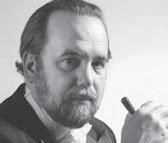
The stresses and strains of the Depression and the war years of the 1940s and early 1950s saw less emphasis in music at Sem, and by the mid-1970s the music department featured primarily student choral group performances.
The opportunity to build the Buckingham Performing Arts Center in 1976 and the hiring of John M. Vaida in 1975 brought a renaissance in Sem’s music program. Vaida remembers that when he came to Kingston as head of Sem’s music department, the school’s instrumental program consisted of one piano that didn’t work, and no practice rooms, instruments, equipment or music. He shared the school leadership’s vision of creating a new high-quality instrumental and vocal music program that would compare favorably with other independent school programs. During his nearly 45-year tenure at Sem, Vaida and his performing arts faculty have revitalized the orchestra, established a jazz band and several instrumental ensembles, elevated the vocal program through the award-winning Madrigal Singers and the Chorale, and enhanced the music department’s curriculum with classes in composition and arts appreciation. The department’s repertoire now rivals that found at the collegiate level; students perform on concert-quality pianos and harpsichord; and the Madrigal Singers have traveled throughout the world, winning prestigious competitions in Europe.
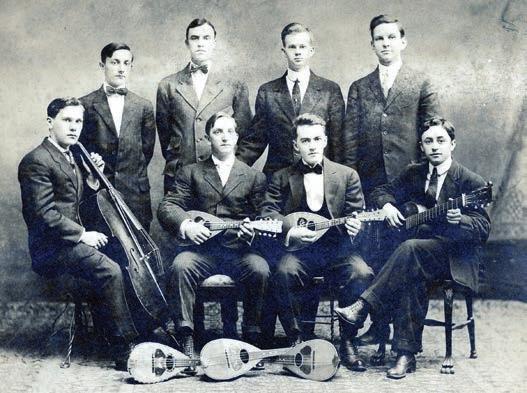
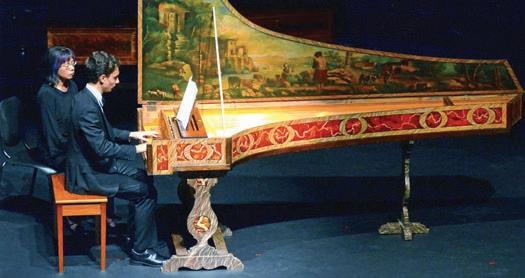
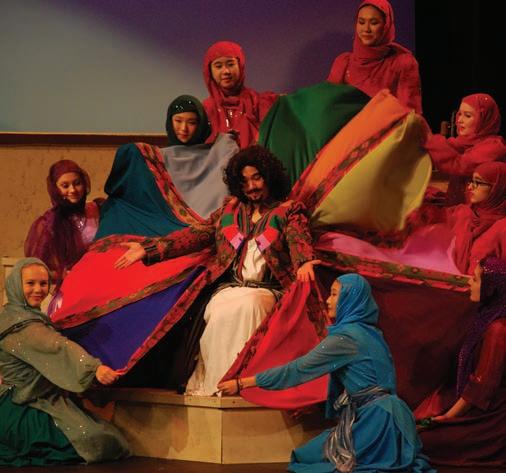
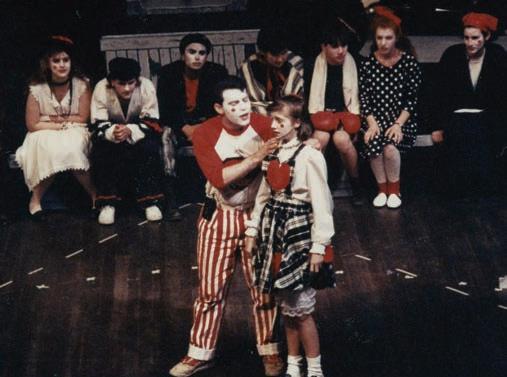
PROGRAM DIRECTOR: JASON SHERRY '90
The roots of today’s Wyoming Seminary Players stretch deep into the school’s history. From the beginning, Sem students presented pantomimes and colloquies, and the early literary societies competed with each other to offer entertaining skits and dramatic acts. Sem’s very first real play production in 1912, “The Taming of the Shrew,” was presented by the Amphictyon and Adelphian Societies, but it was not until 1923 when the new Student Dramatic Club took the name The Nutcrackers and began using scenery and costumes. Later, intersociety play contests, held in the spring and presented in Sprague Hall’s basement, helped garner points for the societies. LOUISE LOUCKS MOORE ’55 remembers taking part in those plays, and when she returned to Sem in the fall of 1966 to teach English and public speaking, she decided the time was right to form a new theater company.
Her Wyoming Seminary Players debuted with a production of “Pillow Talk,” staged in the Pettebone Gymnasium, and laid the groundwork for more than 50 years of outstanding dramas, comedies and musicals, all featuring students and even some faculty and staff.
Although the Agnes Flood in 1972 forced the demolition of the Pettebone Gym, Moore and fellow English faculty member, the late Carver Collins, continued to mount productions in various locations such as Fleck Hall, the Lower School and the Church of Christ Uniting. They worked together with John M. Vaida to help design the Buckingham Performing Arts Center, and in 1977 the Players presented the hit musical “Bye Bye Birdie” on the new stage.
Sem’s vibrant theater program continues today in both the new Kirby Center for Creative Arts, where each fall the Players present a Broadway-style musical production, and in the Buckingham Performing Arts Center, where the students offer a winter-term black-box Theater Winter Workshop and a spring drama or comedy. The Winter Workshops provide students with opportunities to write and direct their own short works, and are open to all students — those who are sampling acting for the first time as well as Sem’s more experienced thespians.
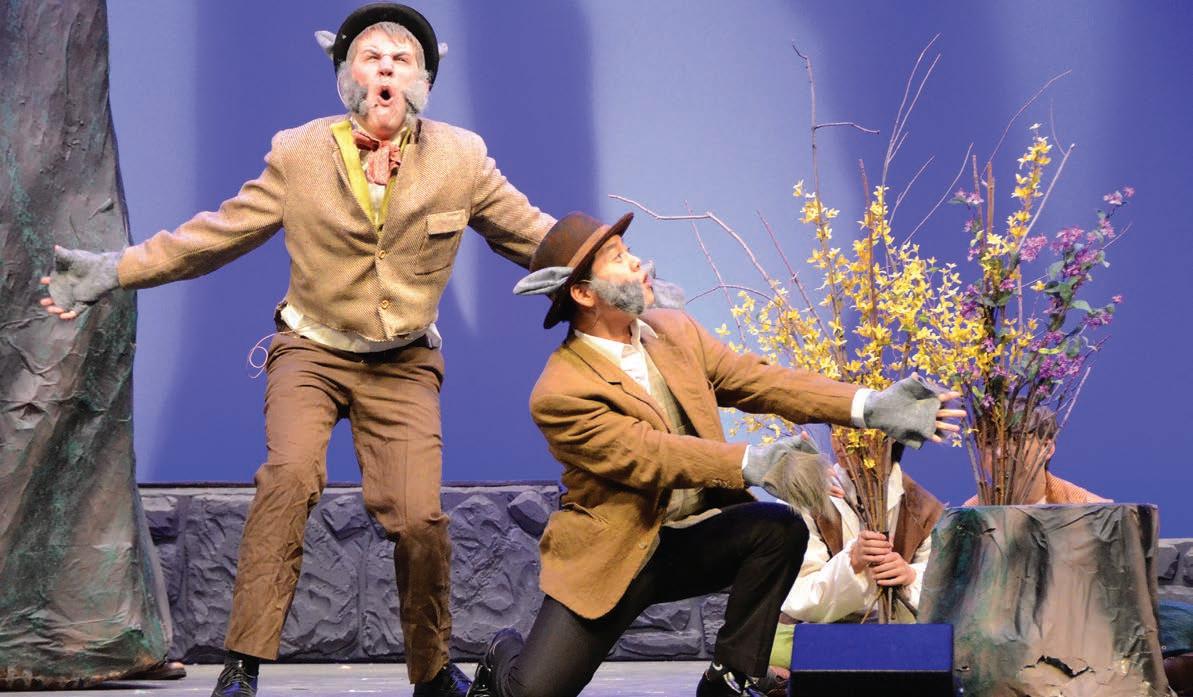
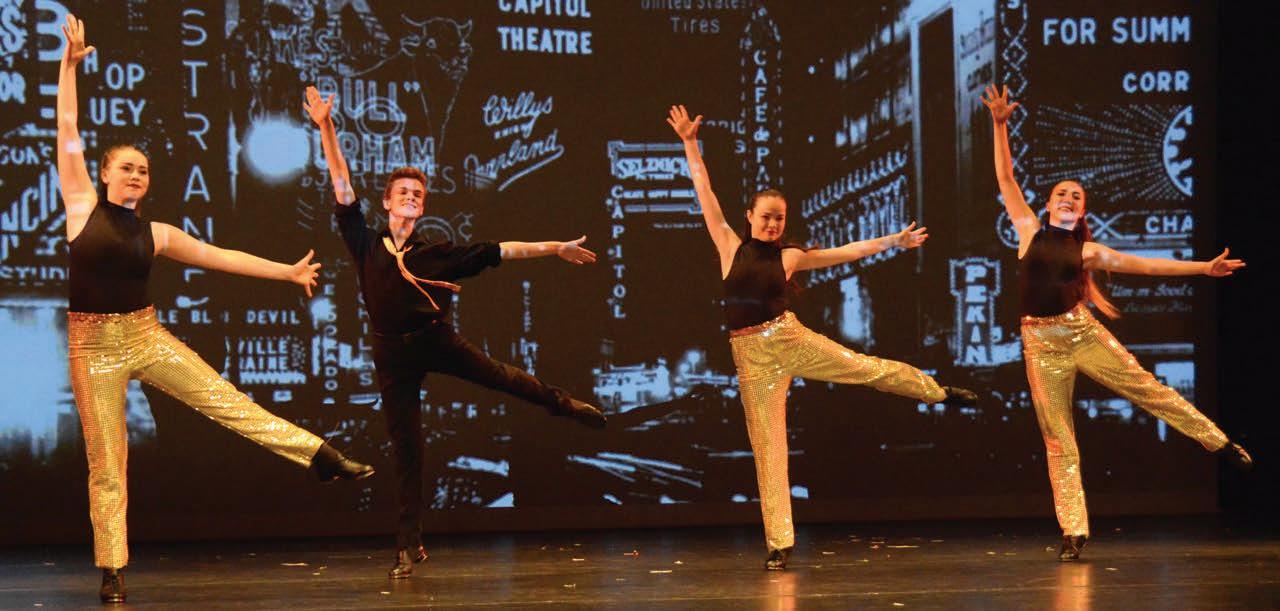
PROGRAM DIRECTOR: BERNARDINE VOJTKO
Although Wyoming Seminary students had for many years participated in dance-related events such as May Day celebrations and Maypole Dances, it was not until 1979, when local dance teacher Linda Sipple joined the Sem community, that the school began offering formal classes in dance and opportunities to perform. Two years later, upon Sipple’s departure, Bernardine Borinski Vojtko became director of the dance program and established the Sem Dance Company. This performing group, open to all students interested in dance, offers a rigorous yet enjoyable dance experience grounded in technique, discipline, appreciation for the art of dance, and creative expression through movement. Dance Company members take classes in ballet, jazz, tap, hip hop, yoga, swing and choreography, and the Company presents dance works created by faculty, alumni and upper-level students. The Company now includes 50 students in grades 5-12, and additional primary students from Lower School also appear in dance productions. Vojtko’s Lower School creative dance program also offers weekly classes to students in grades pre-kindergarten through second.
In addition to the visually-stunning annual dance production in May, Dance Company members may perform in the fall musical, and Vojtko works closely with her Sem music and theater colleagues to present an outstanding performance each year. Dance Company members have performed with the Sem Orchestra and presented liturgical dances at chapel. In spring 2018 the Company presented “Peter and the Wolf” with the Northeastern Pennsylvania Philharmonic. Over the past three years the dance program Sem Dance organized a Sem Dance Weekend event which invites local dancers to take classes with master teachers such as Barbara Sandonato, first principal dancer of the Pennsylvania Ballet, and to feature the dancers in an evening community performance.
With the addition of the Kirby Center for Creative Arts, the Sem dance program now has a large, professional performance space and two studios: one in the Kirby Center and the restored dance studio on the second floor of the Buckingham Performing Arts Center.
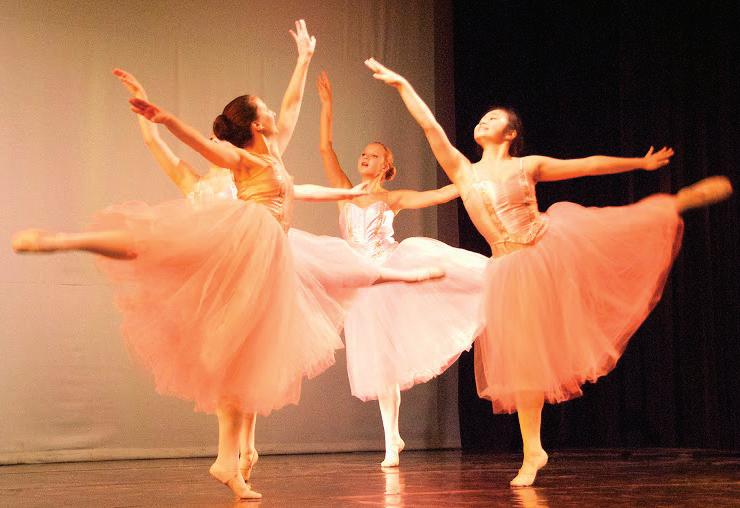
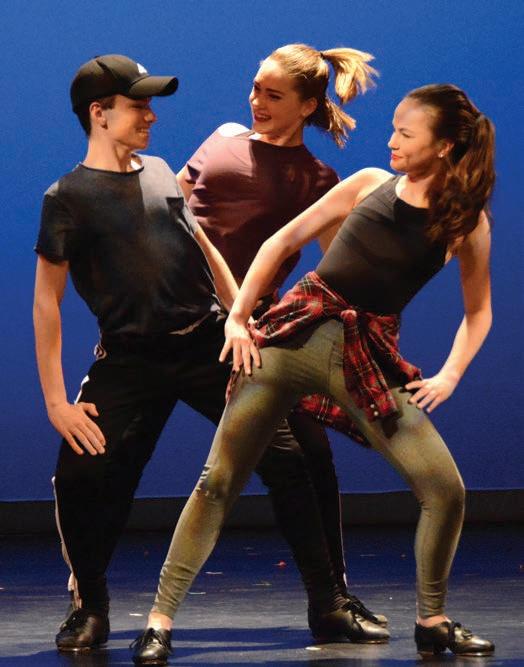
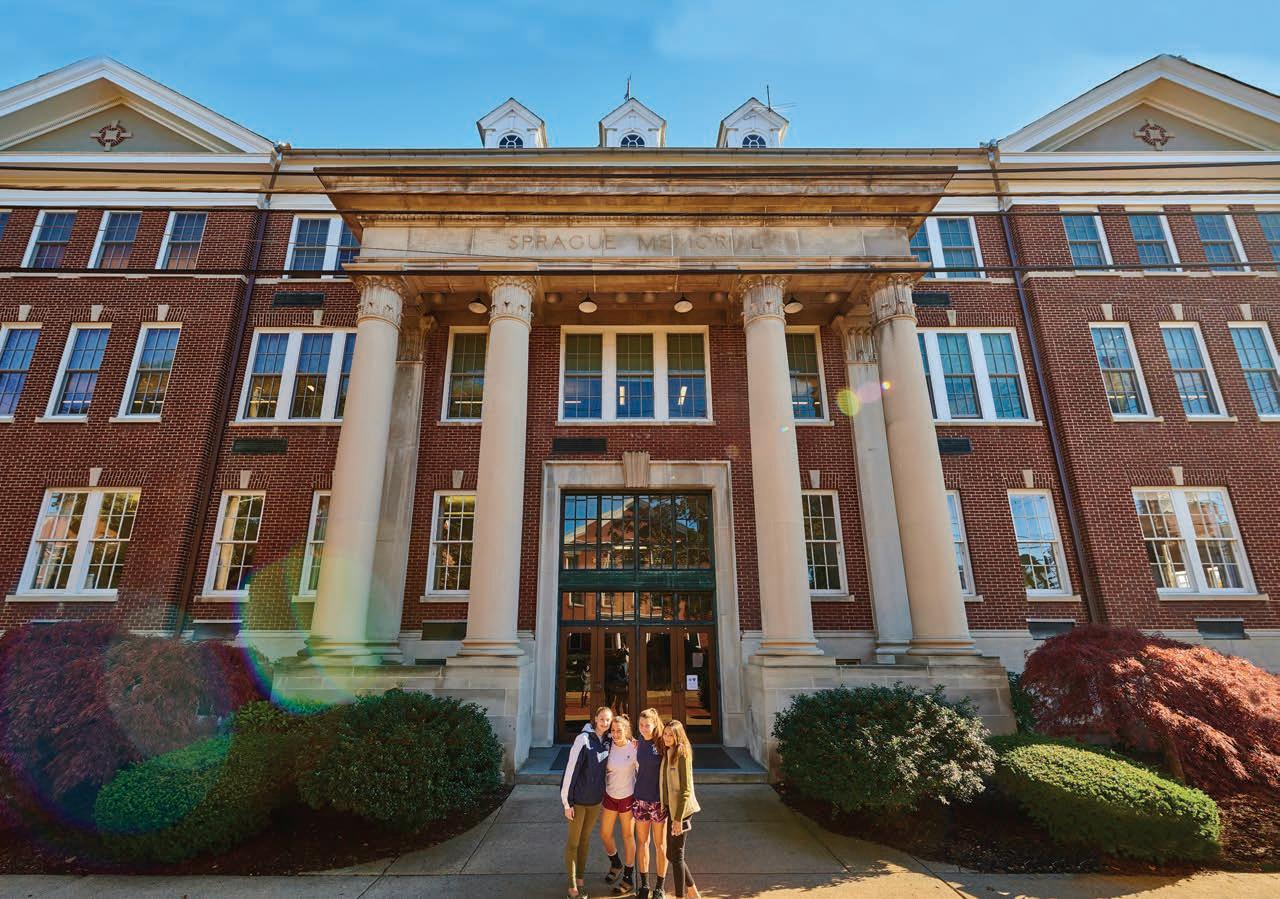
classrooms. Their stories are as different as can be, and their paths are charted in myriad different directions. But when they have all walked across whatever form the graduation stage has historically taken, they have left the Sem campus armed with the gifts of clear and cohesive writing, analytical thinking, and courage to express themselves publicly with confidence and conviction.
Students arriving at Sem in the early days chose courses such as Spelling, Penmanship, Logic, Elocution, Natural Theology and Natural Philosophy. They could enroll in languages such as Greek, Italian, and German. Most students took a very limited number of courses, perhaps as few as one or two.
However, there were many classes offered in the mid 19th century that students today would recognize. The teaching of Latin, French and Spanish has been continuous at Sem, as has the study of algebra, geometry, trigonometry, chemistry and biology. Another constant has been a commitment to the arts, as the music education classes of the 1860s run parallel to the Masterpieces of Music and Music Theory classes of 2019. Student-produced visual art no doubt adorned the walls of Centenary Hall much the way they do Sprague Hall today. Although Sem no longer sponsors a Music Conservatory branch, there is no question that its founders would be proud of the music, theater and visual arts being fostered on campus today.

By Randy Granger and Jay Harvey ’80
Thousands of miles of chalk (and pounds of accompanying chalk dust). Millions of pens and pencils. Truckloads of paper. Hundreds of thousands of students, and several thousand faculty members. Countless success stories. All of these are the ingredients for the recipe of 175 years of education at Wyoming Seminary. Since 1844, students from around the region, the country, and the world have made their way to Kingston, Pennsylvania, to attain an education that would open doors and fully inform their next educational step. Originally they walked or came in horse-drawn wagons; eventually they took trains and then were driven in automobiles or buses; and now dozens fly thousands of miles from the other side of the globe to take their seats in Sem
Evolving technology has changed the way the curriculum has been presented throughout the years. Chalk on slate boards carried the day through the school’s first 150 years before being blended with dry-erase white boards and colored markers. Now it is difficult, if not impossible, to find a chalkboard at Sem. Most classrooms have ceiling-mounted projectors to enhance the curriculum. Problem sets can be projected, meaningful video clips can be shared, and teachers can use a vastly diverse set of tools to deliver the promise of a Sem education. Imagine being a student in the early 1900s and being able to discuss the 13th Amendment by watching a clip from Spielberg’s “Lincoln” movie!
Teachers have always faced the challenge of
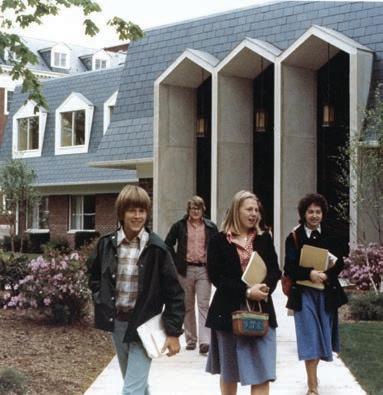
meeting students “where they are,” and the resources in the Sem classrooms have grown to meet that challenge. Textbooks were originally slim and contained no pictures or color. The math and science texts of today would be unrecognizable to the students of the first half of the school’s existence. They are larger and contain more pictures, diverse problem sets, and additional study guides. And they cost a significant amount more today than the streamlined, almost pamphlet-like books of year’s past.
But, in the broad and successful history of
Wyoming Seminary, one thing that remains as recognizable to a student from the 1840s as it would to a recent graduate is the selfless dedication and passion of the faculty. From Leroy Bugbee and Charles March, through Horace Parker and Helen Brown, on to Harry Nageli and Edith Pillarella, and now to Jane Slaff and Clark Switzer, the quality of the Sem faculty has endured. They are and have always been men and women dedicated to the ideals of education, and who have given time and great care to their students. Many have served as dorm parents, quite literally being the in-contact parents (in loco parentis) to children from near and far. They have spent countless hours in the classrooms, studios, and on the courts and fields engaging in what one Sem leader referred to as the “Mission” of independent school education.
It is this unbroken chain of excellence of the faculty that has allowed Sem to flourish through countless changes to curriculum, through numerous building evolutions, advancements in technology and textbooks, and to the rapidly changing external world within which the campus centered at the corner of Market and Sprague must fulfill its Mission. Truth, Beauty and Goodness surround us at Sem, and nowhere is it more evident than in the compassionate faculty and staff that have been its true foundation for 175 years.
By Jill Snowdon
LILLIAN DAVIS SMITH
‘53 doesn’t recall exactly how she got recruited into writing for The Opinator. She doesn’t think she had the courage back then to volunteer her writing services. And, she doesn’t necessarily remember it being a requirement.
What she does remember: it was a part of her experience at Wyoming Seminary that helped her gain comfort expressing herself with the written word.
In a time when the future of the present-day newspaper industry is often uncertain, The Opinator remains alive and well. It was first published in 1883, making it the longestrunning club at Wyoming Seminary.
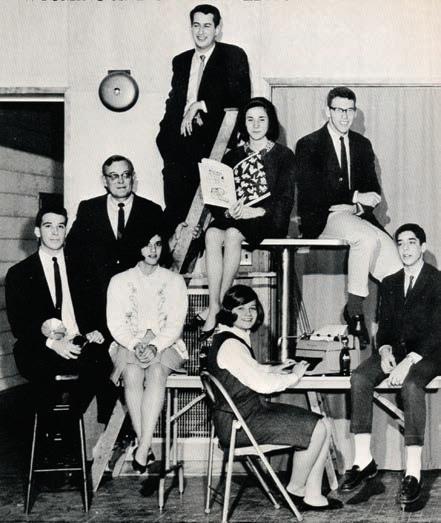
“It’s such a creative opportunity for young people and I’m tickled that it is still being published,” Smith said. “I feel the written word is dying fast and the faculty and students keeping this alive are to be applauded.”
In the initial years, the publication was called The Seminary Opinator; in 1917 it became known simply as The Opinator.
It was originally published the second Friday of each month by the Aldephia, Amphictyon, and Independent Societies.












By the early 1900s, it was published weekly throughout the school year and featured ads for universities and local businesses.
By 1939 The Opinator was the platform for expression for Sem students. Original artwork decorated the covers and were reflective of the events of the world, not just life on campus.
More art, essays, short stories, poetry, and reviews filled the pages.
“There was a bit of an authority to it,” said Smith, who began writing for The Opinator in 1952 as a junior. “It was a literary piece and it was your chance to put yourself out there as a writer.”
Smith’s older sister ELLEN DAVIS BENDER ’48 also was a writer for The Opinator.
“The board room was on the third floor of Sprague Hall and you dropped your stories off under the door with hopes that someone would pick them up,” Smith said.
For a short stint (2011-2013), The Opinator eliminated print production and published only online. It was the 2013-2014 staff, however, that proposed The Opinator be brought back to print, while also maintaining its internet presence at theopinator.org.
“The online option is a great way for our alumni to see what the students are writing about,” said Ivy Miller, who has served as faculty advisor of The Opinator for the past 14 years. “Our format (print and website version) really works for us and it’s nice that our school community and alumni are committed to keeping The Opinator alive and thriving.”








The writing staff of the present-day Opinator are students who participate as one of their EXCOLO options. In addition to the online version, the four-page printed copy is now published once each term and includes sports, arts, entertainment, news, and features in each issue.
“I always get the most ambitious kids who are determined to make The Opinator the best it can be,” Miller said.
In the 136 years of its publication, The Opinator has taken shape in different “newsrooms,” has endured different layouts, changed with the decades, and conformed to the interests of the school community.
There is, however, a certain pride in being an Opinator staff member that is timeless.
“It was always fun seeing your writing in print,” Smith said. “A lot of work went into writing those stories so it was a proud moment to have it printed and hold a copy in your hand.”
“The kids are still so excited when it comes out,” added Miller. “They wrote it, they designed it, they created it and it’s a thrill to them to have it published.”
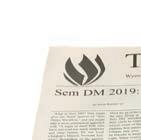

Since its first issue, The Opinator (which means “One who holds or expresses an opinion”), a student-produced and managed publication, has offered news, sports, opinion and observations about the life and times of Wyoming Seminary’s community.
The very first issue. The paper is published the second Friday of each month of the school year. The early issues have very few illustrations and feature essays, personals, short items about the campus and sports and amusing anecdotes in a magazine format.
The Seminary Opinator begins publishing weekly throughout the school year and is distributed on Tuesdays.
The publication drops the Seminary from its banner. A variety of student drawings, cartoons and artwork appear on the pages as well as on the cover. Issues come out on Thursdays.
Now distributed every Friday, the issues include multiple pages of ads from local vendors. This publication style is remarkably successful, and the format stays the same for nearly 40 years. With essays, jokes, articles, reviews, original artwork and short stories, The Opinator presents a lively view of Sem life.
The Opinator format changes to a four-page broadsheet style. The publication features a new banner in an Olde English-style font and offers one page each of news, opinion and sports with a full back page of ads. One or two issues are published each month.
The 1980s usher in a change to a tabloid style of newspaper, featuring many more photos and a monthly publication schedule. The banner also changes and incorporates the school seal and Fleck Hall cupola.
The Opinator is printed on newsprint for the first time. In the banner, the Olde English type is replaced by a modern font and the Sem seal.
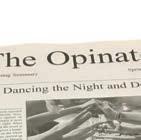


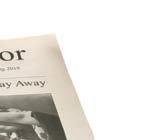


A new banner highlights the Blue Knights mascot and presides over a new design for the monthly publication. The paper features defined sections for news, features, arts, opinion and sports.
2010
The Opinator takes the leap to digital publishing and can be found at www.TheOpinator.org. One issue is printed each term.
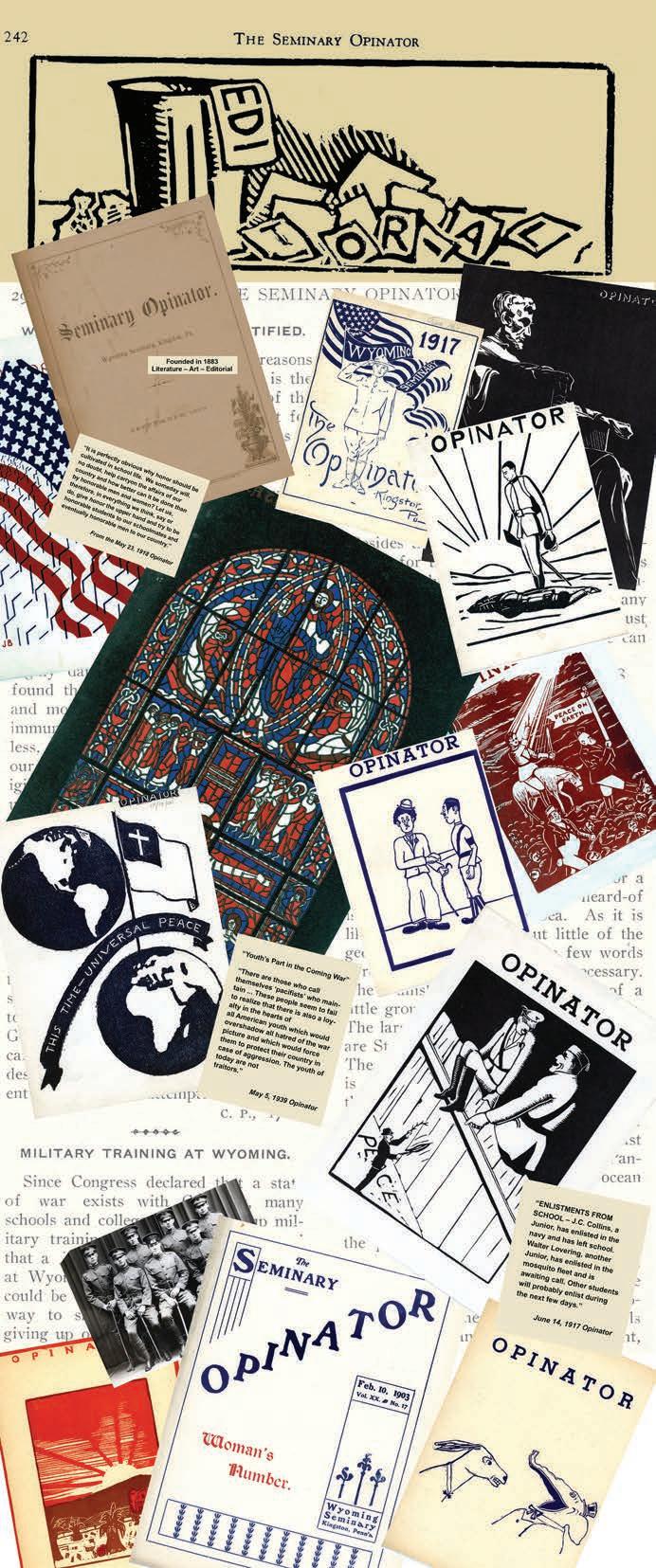

By Clark Switzer
It was a cold day in 1909, and the radiators were hot in the Wilkes-Barre Institute. That was a perfect scenario for one of the scholars (or maybe more than one) to smear Limburger cheese onto the surface of one of the finned heaters. The smell drove everyone home for the day. Ten years later, the stunt was tried again. This time, no one was allowed to leave. Anna Miles Olcott was now in charge at South Franklin Street. The prank was never tried again.
In 1923, WINIFRED SCHOOLEY ’40 was in third grade at the Institute. By the time she arrived in the 1920s, however, the girls were still playing recess on the sidewalk as long as they didn’t venture farther than half a block from the school. On rainy days, they could use the front porch to jump up and down — but there was no ball throwing! The lack of recreational space and the cramped classroom quarters in the former home of Judge Woodward did not fit into Miss Olcott’s vision of a proper school — something she
had wanted for years. Her ideas took shape as a school committee researched building plans for a year before erecting their own new school in Forty Fort in 1925 for $507,688.27. Miss Olcott contributed $17,000 from her own savings.
Winifred eventually became an English teacher in that building though it now had a new name: Wyoming Seminary Day School. Commissioned to write a history of the schools by Dr. Wallace Stettler (then president of Wyoming Seminary), she is responsible for bringing together much of what we now know about the three predecessor schools.
While a few warm memories have been recorded since the 1807 Wilkes-Barre Academy days, it is the Forty Fort building that houses the more recent fond recollections. Due to financial challenges to the Academy and the Institute, by 1938 school leaders feared that the building would not even continue to be a school. Fortunately, a plan to merge the two schools into the Wilkes-Barre Day School in 1939 was put into action. It was while at WBDS that
BETSY BELL CONDRON '45 met her future husband while both were in eighth grade—in the library’s biography room.
By 1951, WBDS merged with Wyoming Seminary and the building had a new moniker, Wyoming Seminary Day School. Soon HARRY SCHOOLEY ’63, nephew of Winifred, and his brothers, MATTHEW ’71 and JOHN ’66, began a relationship with the school that still continues. Harry remembers Bessie G. Atwood, who started with the Academy in 1920 and didn’t retire until the mid-1960s. She was a remarkable teacher and actually lived at the school in a second-floor apartment. (There was another apartment on the first floor.)
BARBARA DEWITT SMITH ’59 remembers Miss Atwood giving a lesson on inverted fractions to her sixth-grade class:
“’How many of you know what “inverted" means?’ she asked her sixth-grade class one morning.
Dead silence.
“’Well, then, I shall show you,’ Miss Atwood said. ‘Danny, will you come up here please, and stand next to me?’ she asked DANNY WOEHRLE ’59
“Miss Atwood made him stand in front of her, facing the class. She took off his clearframed glasses and placed them on her desk. We were all very silent to see what she was up to. Then suddenly, without a word, she bent over, took Danny’s ankles in her hands and pulled them up to her shoulder.
“’Whoa,’ Danny said as he reflexively put his hands to the floor and found himself doing a surprise handstand, with Miss Atwood still holding him by his ankles, feet pointed toward the ceiling.
“’This is what inverted means — upside down,’ she said in her crisp Maine accent, with the ‘r’ barely audible.
“She let go of Danny’s ankles as quickly as she had grabbed them so that he could stand on his own two feet again. And that’s how Miss Atwood taught a bunch of Day School sixth-graders what an inverted fraction meant. Frankly, I never forgot the lesson,” Smith says.
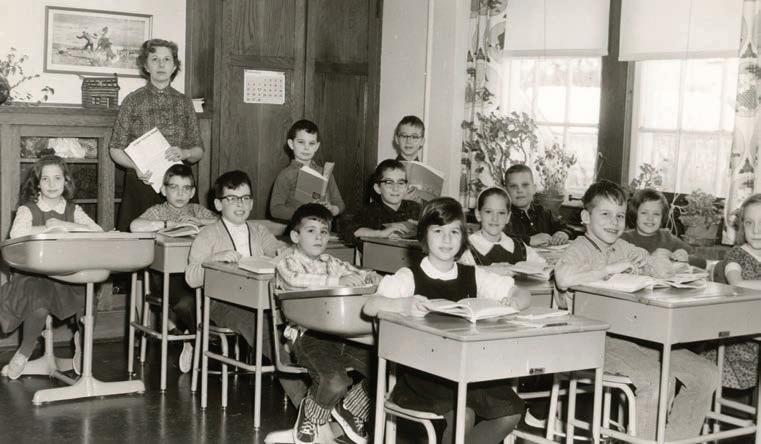

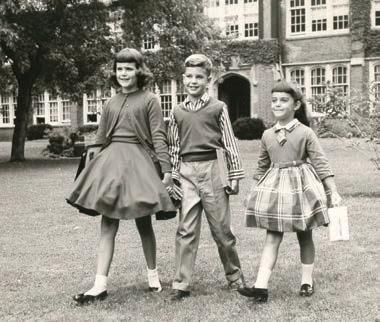
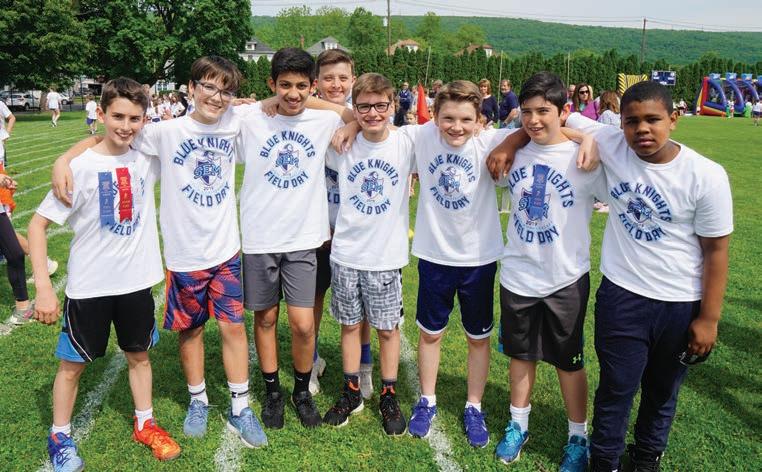
Anyone who spent time at the Payne Pettebone House as a kindergarten student remembers the Maypole dance. The artful weaving of the long, colored ribbons held by each five-year-old while walking around the pole is still performed more than 60 years later. At the other end of the spectrum is the publication of the school yearbook that now features the eighth-grade class. The Academy (both Wilkes-Barre and Harry Hillman) had The Rocket, while the Institute had the Tatler (which still exists to this day.) While formats and sayings have changed, the sentiment of memories is still very powerful.
Field Day today revolves around the traditional foot races for each class, along with the competitive Blue/White relay race. There is a food tent, dunk tank, and a variety of baskets to bid on while the children play in-or-on blow-up slides and bounce houses. In 1917, it was much different as the students performed intricate exercises on the tennis court. Three young dancers performed the Dance of Spring while wearing white robes and wreaths of spring flowers. Assorted folk dances and drills performed by 80 students attired in their exercise uniforms (a plain white middy blouse with a WBI patch, black bloomers, black stockings, low white sneakers and, a yellow kerchief) closed out the day.
Today’s eighth-grade students still wrestle with their speech topic and often fight the “jitters” as they speak to their peers just like generations have done before. Back in the early days of the Academy, declamations were performed every Wednesday while writing was done on Saturday mornings. Learning how to write and prepare to speak in front of others is a tradition that dates back to 1807.

“ There never was greater need for genuine, far-reaching education than there is today

ANNA MILES OLCOTT in 1912 “
the school curriculum, was Miss Stroud’s dance class. Harry Schooley remembers, “this was every Friday after school for what seemed an interminable number of weeks.” Held in the gym, the middle schoolers had the class in the evening. They were required to dress up as if for a formal function.
“For me, dancing class made purgatory seem short,” Schooley says.
“I think many of my male friends felt the same way. The girls loved it. They got to dress up and check each other out. The girls who were our classmates during the day were transformed into gorgeous beings — strangers almost, who dazzled and scared us boys with their sudden maturity.
“Boys lined up standing along the gym wall. Lined up across the gym were the girls who were seated. We then moved as a line across to the girls opposite. We would bow and say, ‘May I have this dance?’
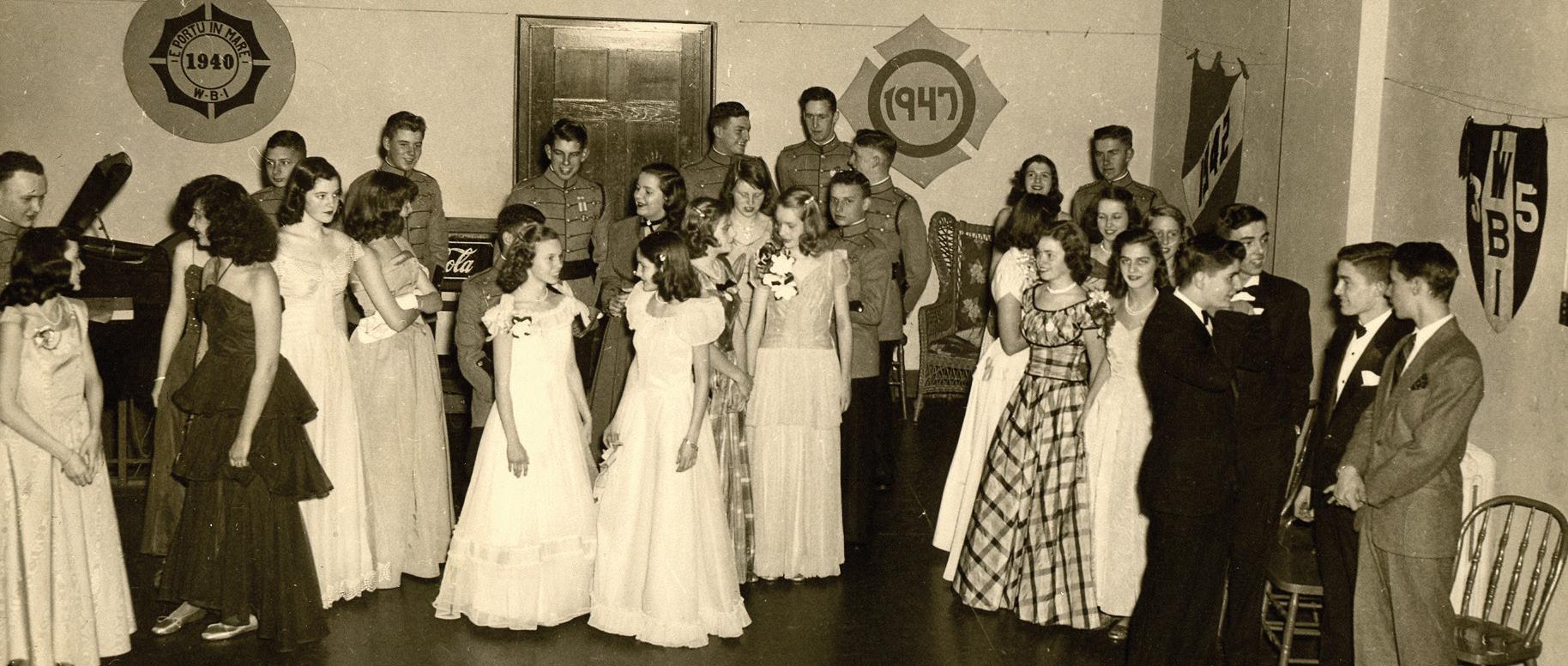
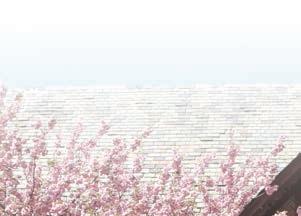
One part of the school that is often recalled, though it was not part of


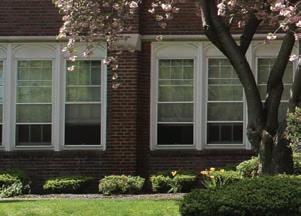
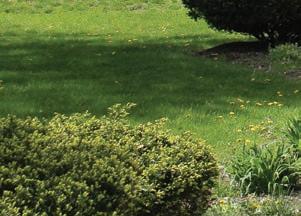

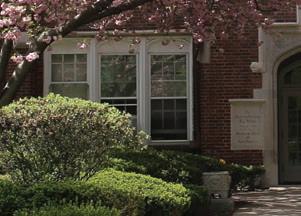

Then, with our partners, we'd go out on the floor and wait for the music (piano) to start. Mrs. Stroud would weave among us clicking castanets — yes, castanets! — to stop the music and chastise us for our clumsiness or failure to understand the steps. The girls were much quicker learners than the boys, so they often would lead. Clickity clickity clickity ...” MAY

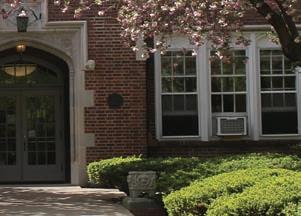
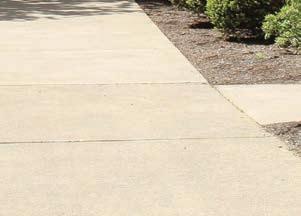
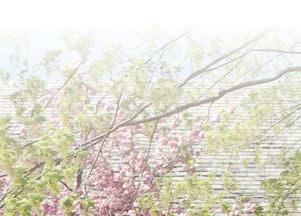

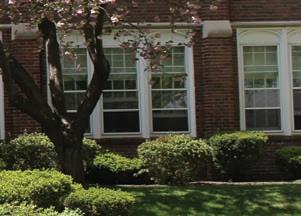
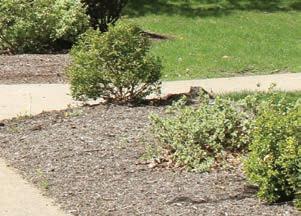

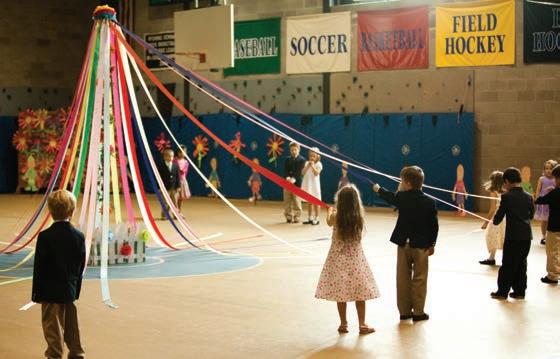
Have other memories to share? Send yours to cswitzer@wyomingseminary.org so we can post them from time to time.
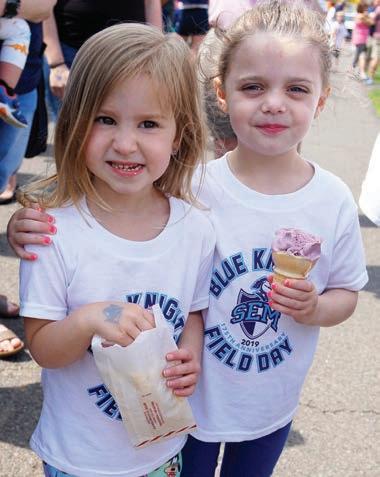
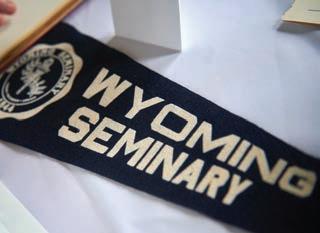
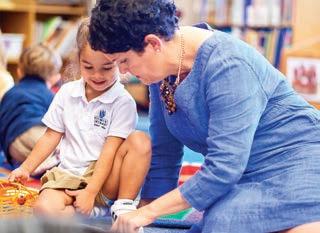
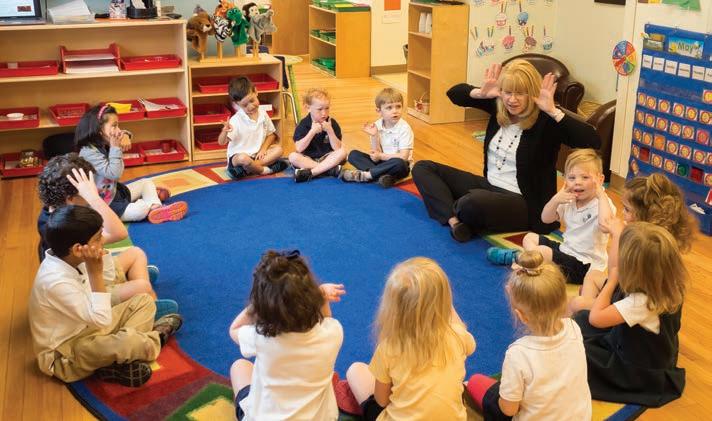
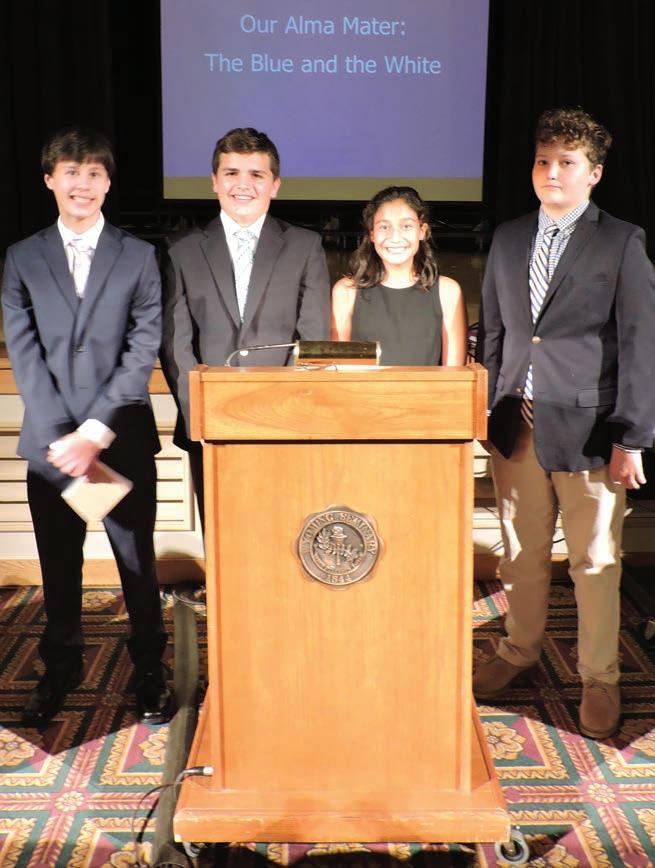
TBy Liz Hibbard ’69
he senior oration. Do you remember yours?
“It was a frightening experience! I remember everything about mine,” said LILLIAN DAVIS SMITH ’53. “I remember what I wore and the feeling of my heart pounding as Dr. Decker introduced me. My topic was “The History of Surgery” and I presented the day before we broke for Thanksgiving recess. I remember feeling so much relief when it was over and then going off to the Army/Navy game.
“I’ll never forget there was a big, tall, athlete scheduled to give his oration and just as he was introduced, he passed out right in front of everyone. He eventually had to deliver his speech, but he did so during the Business School chapel, which was a much smaller audience.
“When I was here for my 50th reunion, many of us were talking about the Senior Oration and everyone remembered the first line of their speech. Mine was ‘the history of surgery is a part of the history of medicine and must be understood as such.’
“It was very daunting at the time, but looking back, do think it was an excellent discipline. It gave me great courage when I went on to college… I think it was the paramount discipline.”
The arts of public speaking, debating and acting have been an essential part of the Wyoming Seminary curriculum since its founding. Recitation and declamation exercises were common activities in and out of the schoolroom throughout the 1800s and 1900s. In the 1800s, Sem required each senior to speak three times before the student body; the boys provided orations and the girls read original compositions. In the early 20th century, Sem offered a three-year course in Oratory, and by 1930 students could receive a
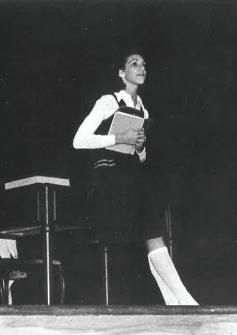
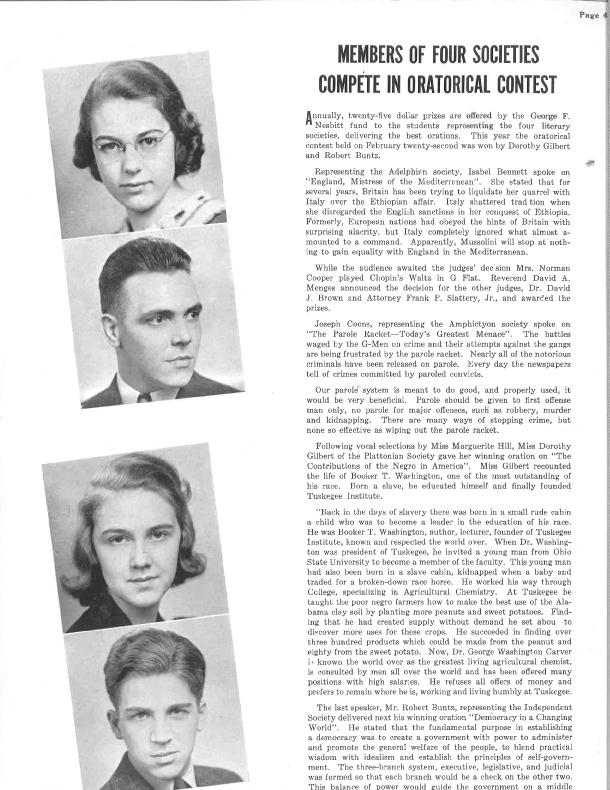
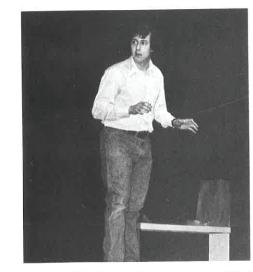
Sem's public speaking tradition includes the Declamation and Oratorical contests.
They may walk in a bundle of nerves but they get through it. And the payoff every time, for every kid, is astounding.
- Cecilia Galante, teacher
four-year diploma in public speaking. All seniors were required to give a formal speech, eight-10 minutes long, before a suitable group sometime during the year. The subject of the speech was approved by the English department and each speaker was trained by public speaking teachers. As the curriculum changed over the decades, so did the public speaking program, and by the late 1990s, while still a requirement for graduation, the program became a trimester course, as it is today.
Wyoming Seminary Lower School also has a public speaking tradition. According to Clark Switzer, chair of the history department, “public speaking” at the Lower School began in 1807 at the first predecessor school,
the Wilkes-Barre Academy. For at least 100 years, eighth-graders have prepared for and delivered a five- to seven-minute speech in front of the middle-school faculty and students.
The speech process begins in seventh grade when students complete a semester-long course called I-Present. This class teaches students the basic fundamentals of speech writing and presenting, information gathering and presentation. In eighth-grade, the students expand their speeches to present a persuasive argument.
Just as with the Upper School’s Senior Oration, eighth-graders “freak out a little about the speech, but it’s the fear of public speaking, not the preparation, that worries them,” said
I-Present teacher Cecilia Galante. “They may walk in a bundle of nerves but they get through it. And the payoff every time, for every kid, is astounding. They grow. Mature. Bloom. I see it all year long.”
“I am so proud of these students who get up in front of an entire auditorium and professionally present their arguments,” I-Present teacher KAYANNE VANDERBURG BARILLA ’84 said. “What an amazing accomplishment for 14-year-olds!”
A fear of public speaking is a more pressing concern than death, according to a ranking of society's most pervasive fears. Sem’s Lower and Upper Schools have successfully addressed this human fear for 175 years.
Kindergarten@Sem - Dawn Leas and the Sem kindergarten class
Jump out of bed -
tired...but excited and looking forward to fun!
By car, by bus we travel to Sem. Ms. Schmaltz and Mrs. Loftus welcome us with hello hugs.
Ready to step into our morning jobs - YAY!
Line leaders and door holder, Let’s see whose turn it is for vowel leader! Pink and purple, blue, red, grey table and chairs.
Where to sit for work time?
Purple for spelling. Red for math.
WHEW!
All that work makes us hungry.
A quick snack before gym class, or is it chorus today?
Teachers welcome us back with more hugs and news of a field trip to an apple orchard!
We take a walk down the hall, down the stairs
to lunch in the cafeteriaChicken noodle soup, oreo yogurt, and boneless bites - YUM!
Yes to RECESS!
It’s just a hop, skip, and jump to dance, dance, dance!
WOW! What a busy day.
And finally... going-home time...
HOORAY for more fun in kindergarten@Sem the next day!


At SEM blue is the color of the sky and the color of the ocean blue. And my bow is blue too.
The smell and taste is very sweet too!
By Logan Chace and Dawn Leas
As part of the 175th school year celebration, Wyoming Seminary invited local poet and educator, Dawn Leas, to work with students in producing poems honoring Sem and reflecting on its history. Leas, who split her time between the two divisions as Sem’s Poet-in-Residence, visited English classrooms of each grade level and led writing exercises of all kinds. These ranged from acrostic poems and sidewalk chalk poetry at the Lower School, to persona poems — writing in the voice of some of our former Sem Presidents — and “13 Ways of Looking at Sem” poems, mimicking the style of Wallace Stevens’ famous poem, “13 Ways of Looking at a Blackbird” at the Upper School.
The students enthusiastically participated in these workshops, learning about their own creative expression as well as facts about our beloved Sem that they may not have known before. Leas also gave multiple poetry readings where she read her own poems and invited faculty and students to do the same.
“Having been a Sem parent from 1996-2011 and a Sem employee from 2005-2012, returning as the Poet-in-Residence was like a homecoming for me,” Leas said. “The year has been filled with reconnecting with old friends and former colleagues, new people, seeing high school students I first met as early childhood or primary students at the Lower School, and of course, reading, discussing, and writing poetry. It didn’t matter if the students liked poetry or not: they boldly showed up to the blank page and put one word in front of the other. Their poems were funny and serious, contemplative and creative. They told stories of community and history, memories and milestones. I was honored to work with them and grateful for their enthusiasm and willingness to give poetry a try.”
Before I leave, I wish to provide
First-rate buildings side-by-side.
A beautiful campus with large facilities
Opening up the door to more possibilities.
A place where learning, art, and athletics grow
Right in the heart of Kingston borough.
Mathematics, science, music and sports
Can be experienced through people of all sorts.
I hope to build a center in which students can converse
To study, to enlighten, to immerse
Themselves in the beauty of education
To make Wyoming Seminary a secure foundation.

By Gail Smallwood
How do you organize more than 1,000 people into one 175th Anniversary photo?
That was the challenge posed to Wyoming Seminary science teacher Christopher Pons and his Engineering Club in June, 2018. The Sem 175th Anniversary Committee wanted to bring Sem students in grades toddler through postgraduate, plus all faculty and staff, into a single photo on Back Campus. And, the goal was to arrange everyone to spell out 175 and 1844-2019.
Pons, a structural engineer, used a 3-D modeling computer program to design a plan that showed where each person would stand. Then he and his 16 students figured out how to lay out the plan, how to move and place each person in position and how to communicate with each other. They knew they had only about 40 minutes to position everyone, and they set up teams to move people, position them and get them ready for the big photo, taken by a drone.
And, on October 23, it all worked!
After all the days and weekends of planning and practice, the students and Pons were thrilled with the project’s success. They enjoyed the opportunity to use the engineering skills and techniques learned in the classroom, and discovered the value of effective communication, perseverance and teamwork.
“It was exhilarating and fun to see it all come together, and when it was over, we were so relieved and happy and couldn’t wait to see the photo,” said
KYLE HROMISIN
’19

For ALLISON HOHN ’20, this project helped confirm her ideas of her future. “This project showed me that the engineering field is where I want to be,” she said.
“I was so proud of all of them. I asked them to take a really big risk and they bought into it completely,” Pons said. “The scale of this engineering project was unlike anything they had seen before and the end product speaks for itself. We have made our mark on the legacy of Wyoming Seminary.”
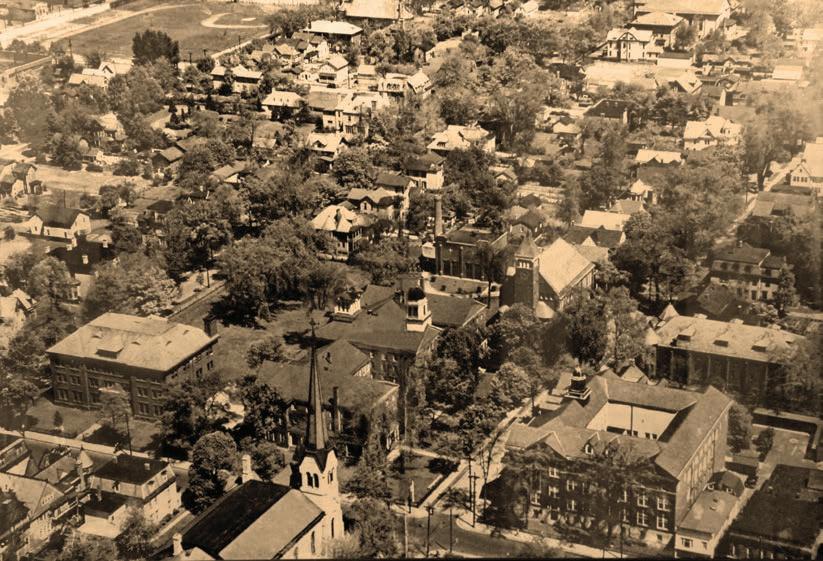

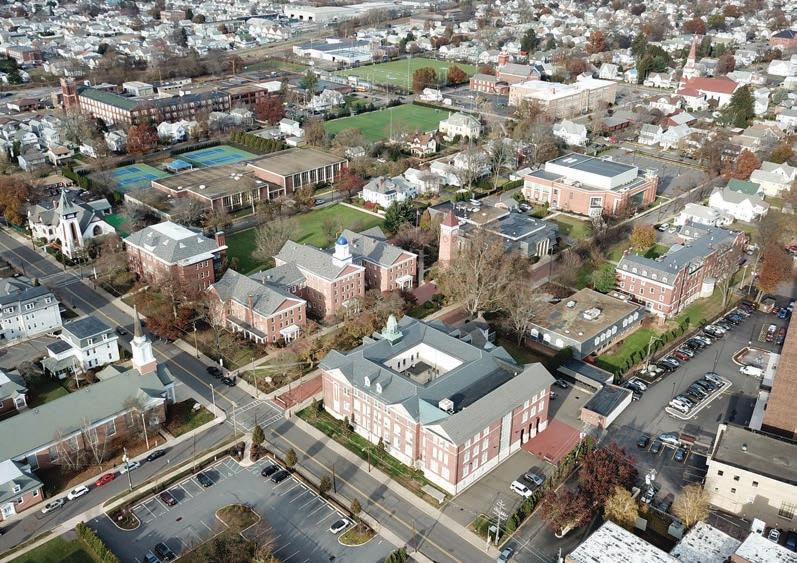
From its 1844 founding with one three-story brick structure, to its current 21-acre campus with 12 buildings, Wyoming Seminary Upper School has grown steadily during its 175-year history. Stately brick buildings, expansive athletic fields, beautifully-landscaped outdoor spaces for socializing and study, and the iconic Bell Tower give the campus a feeling of serenity and collegiality – an oasis of calm amid the bustle of Kingston.
1930s: In this remarkable photo taken during the 1930s, you can see Centenary Hall with its own cupola, Nelson Chapel with the power plant, Pettebone Gymnasium and trees on the Back Campus.
1994: This photo, taken during Sem’s 150th anniversary year, reflects the changes to campus following the 1972 Agnes flood, as well as the construction of Carpenter Hall, Carpenter Athletic Center and the Pettebone-Dickson Student Center. The Buckingham Performing Arts Center also contains the power plant.
2017: Note the new Kirby Center for Creative Arts, new athletic facilities and parking areas, and the new pedestrian Front Campus formed by the 2013 closure of Sprague Avenue.

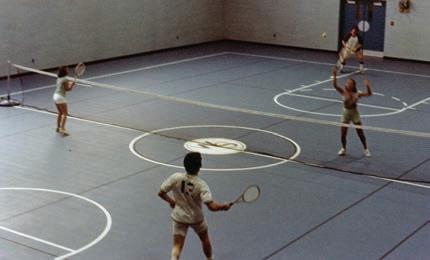
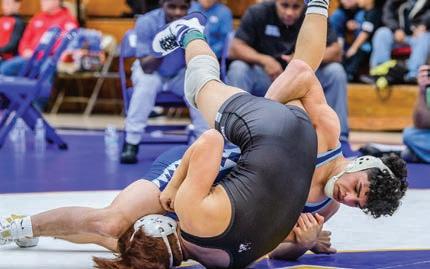
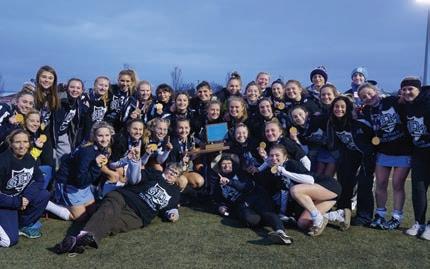
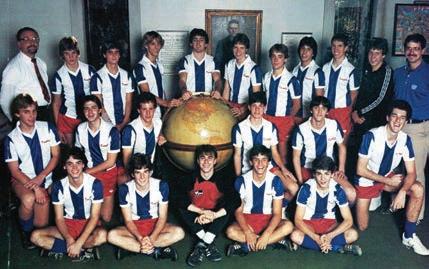
By John Shafer ’71
Athletics have been a hallmark of the Wyoming Seminary experience for male athletes, with baseball played just 22 years after the school’s founding. Football, started in 1883, and the history of Sem are inextricably linked. Sem played in the first night football game in the history of the sport in 1892 against Mansfield Normal School … Sem competed against the Carlisle Indian School and the great Jim Thorpe in 1907 … the remarkable games in the 1920s and '30s against the top college freshman football squads in the East such as Syracuse, Cornell, Penn and Navy … the influence of the athletes and in particular those Sem students supported by the Naval Academy following the end of World War II … the first undefeated – untied football season in school history in 1969 …the remarkable 32-game unbeaten streak in the late 1970s and early '80s, and on and on.
Like their male counterparts, the female athletes at Sem have an equally proud tradition. While basketball became the first sport for girls in 1913, it is the field hockey program, beginning in 1924, that has garnered the most recognition over the past century. Among their many accomplishments are 17 undefeated seasons, 10 appearances in state championship games (Sem joined the PIAA in 1986) and seven state championships. For the past 47 years, Karen Klassner has been the head coach of the Blue Knights, amassing 681 coaching victories with only 171 losses and 46 ties.
“
“ It is the human aspect of the athletic experience at Sem that truly resonates
Sem is equally well-known as a sports pioneer in Northeastern Pennsylvania, introducing and becoming the first high school team to play the following sports – boys wrestling, boys soccer, boys lacrosse, boys ice hockey, girls ice hockey, girls lacrosse, girls soccer, girls wrestling and rowing. One of the most historic events in the school’s sports history took place in summer, 1984 when the Sem boys soccer team became the first United States high school team to compete in China. This may be hard to believe today with all the internationalization of sports, and especially the transformation at Sem, but back in 1984 this was a ground-breaking trip.
In any given year, between 75 and 80 percent of the Upper School student body competes in at least one sport. The 2018-19 athletic year, arguably the best in school history, ended with an overall varsity record of 259-96-12. Sem teams won nine Division Championships, four District 2 Championships, one State Prep Championship (wrestling) and one PIAA “AA” State Championship (field hockey). Perhaps the most remarkable aspect of this past season is that 25.8 percent of the class of 2019 will play intercollegiate sports at the Division I, II or III level.
But it is the human aspect of the athletic experience at Sem that truly resonates. Graduates well into their retirement years still tear up when they express their gratitude for a scholarship given to them by Dr. Sprague or later administrations. The former athletes talk about all the wind sprints, the laps in the pool and the success they had on the playing field. The real smiles light up their faces, however, when they talk about babysitting for one of their coaches’ children or how their coach was available at midnight to help talk them through a tough personal situation. In the end, all the students cheering in the stands and those working hard on the field, the pool and in the gym are, first and foremost, getting a first-class education from teachers and coaches who care about them.
By John Shafer ’71
It seems these days that football is played almost every evening … the days of the first Monday Night Football game are now 49 years in our rearview mirror. It’s hard to believe, but on September 28, 1892, Wyoming Seminary and Mansfield Normal School (now Mansfield University) played in the first-ever night football game at Smythe Park at the Mansfield Fairgrounds. In the gathering dusk, the crowd in the grandstands strained to see through the fog that swirled quietly in the dim light of a new invention – electric lights!
Interestingly, the first night football game was only the fifth game Mansfield had ever played. Sem had been playing since 1883 and had finished 1891 as perhaps the best prep school football team in the nation with a 5-1 record. The players in this first night game used practically no protective equipment. Helmets did not come into play for another 20 years. Sem wore white uniforms, reasoning they would reflect light more effectively; Mansfield wore black. It cost $40 to outfit the entire squad!
The 1892 game scheduled for 7:30 p.m. actually started at 6:45 p.m., perhaps to take advantage of the few remaining moments of twilight. Some of the lights were posted on a pole in the middle of the field adding
a hazard to an already perilous sport. Some accounts indicate that lights were also draped along the front of the grandstand. The game was called at the end of the first half. First, the generator died and the foggy conditions made continuation of play too dangerous. In addition, the playing surface, also the site of many other events at the

The 1892 Wyoming Seminary football team
fair, was full of holes, butternuts, pebbles and “animal residue.” Fireworks on and off the field followed the historic game.
In addition, Sem’s team manager, J. H. Race, was the umpire and Mansfield’s Smith the referee. Sem accused the Normal School of using ineligible players and the officiating was controversial. The world’s first night football game ended bitterly in a scoreless tie.

in history by playing each other again on the centennial anniversary. Since NCAA Division II did not allow Mansfield University’s team to play Sem, MU formed a club team. The game was played at 7:00 p.m. –100 years to the hour after the 1892 game. Mansfield won the rematch.
Before leaving Mansfield, Race submitted Electric commercial that was created to commemorate the game.
Before leaving Mansfield, Race submitted a challenge for a rematch. One hundred years later, Mansfield answered the challenge.
Both teams wanted to celebrate their place
The evening’s highlight was the halftime recreation of the 1892 game. The uniforms and the ball were all from the General Electric commercial that was created to commemorate the game.
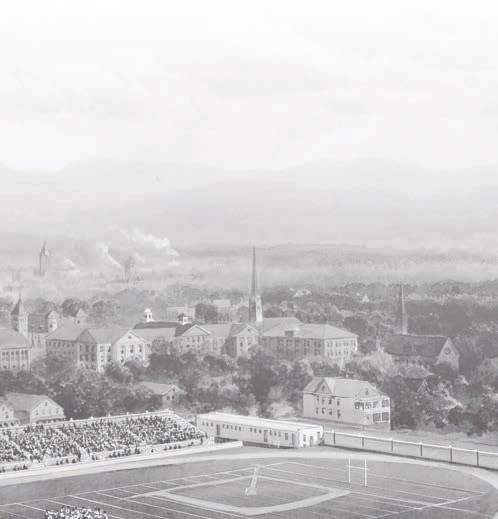
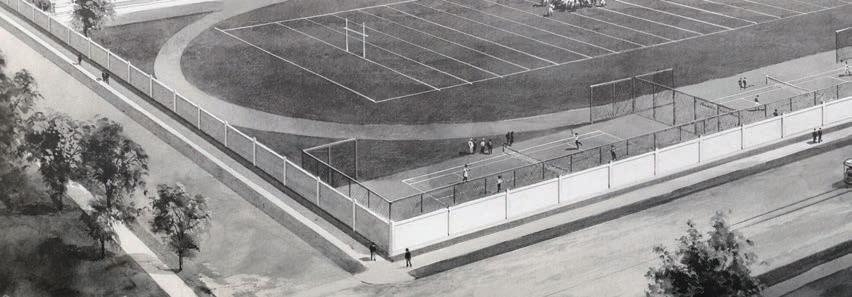
is the first night football game played be-
Every year on September 28, one of the top highlights of “On This Day in History” is the first night football game played between Wyoming Seminary and Mansfield!

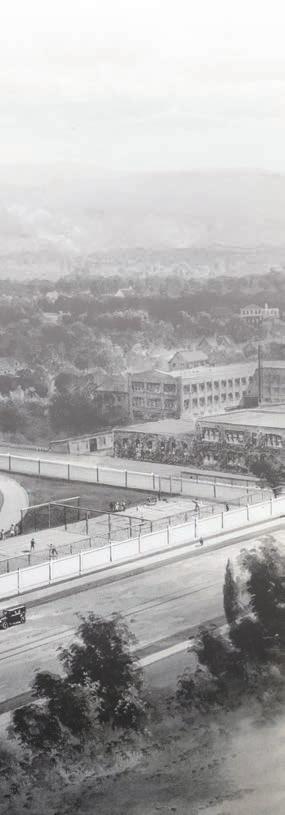
Baseball becomes first sport played at Sem
Football is introduced as a sport
Sem plays in first night football game ever against Mansfield Normal School
Track becomes official sport
First official boys basketball team organized
Boys tennis introduced as a sport
Girls basketball begins play
Field hockey becomes interscholastic sport
Wrestling joins the sports list
Boys swimming introduced
Golf becomes a varsity sport
Girls swimming begins
Boys soccer becomes a varsity sport
Girls softball begins
Girls tennis begins
Lacrosse introduced as a varsity sport; track is discontinued in 1982
Boys cross country and girls soccer become varsity sports
Boys ice hockey and girls cross country begin
Girls ice hockey begins varsity play; team discontinued in 2016
Girls lacrosse begins
Girls wrestling becomes a varsity sport;
Rowing becomes a varsity sport for boys and girls
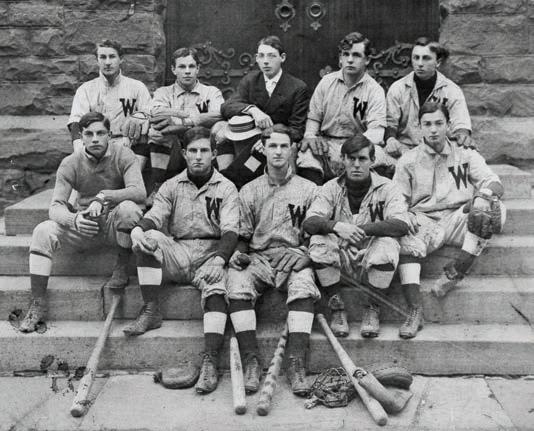


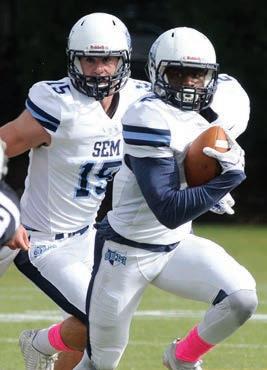

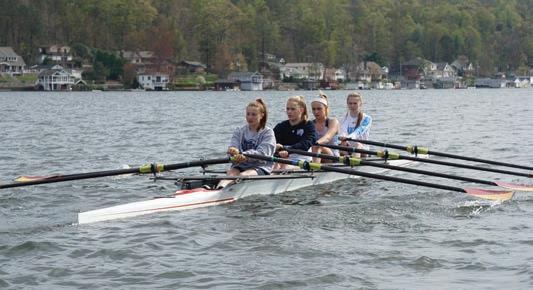

There are nine alumni who have represented the United States in the Olympic Games. Two former Sem wrestling coaches also served as Olympic officials.
WALTER TEWKSBURY 1898 – won five medals in track and field in 1900 Paris Olympics.
WILLIAM BOWMAN 1890 – competed in three fencing events in 1912 Olympic Games in Stockholm.
MARGARET P. HOFFMAN ’29 – a member of the Olympic teams of 1928 and 1932 in Amsterdam and Los Angeles, she placed fifth in the breaststroke in both games; held the world record in the 200 meter breaststroke in 1930s.
IRVIN “BO” ROBERSON ’54 – broke Olympic record in long jump in 1960 Rome Olympics at 26 ft. 7⅜” but took silver medal as teammate Ralph Boston won the gold with 26 ft. 7¾”.
DAVID M. MICAHNIK ’55 – participated in 1960 Rome games, 1964 Tokyo games and 1968 Mexico City Games in fencing (epee); won gold in 1960 U. S. National Championships.
HOWARD WINFREE ’57 – Howard and the entire Navy varsity eight crew team competed in the 1960 Rome Olympics, finishing fifth.
LAUREN POWLEY ’02 – competed in 2008 Olympic Games in Beijing.
KATHLEEN “KAT” SHARKEY ’08 –competed in 2016 Olympic Games in Rio de Janeiro.
KELSEY KOLOJEJCHICK ’09 – also competed in 2016 Olympic Games in Rio de Janeiro; team finished in fifth place, best in 20 years.
W. AUSTIN BISHOP – wrestling coach at Sem (1928-1937); wrestling referee in 1932 Los Angeles Olympics and 1936 Berlin Games.
RAYMOND SPARKS – wrestling coach at Sem (1937-42, 1946-49); wrestling referee in 1960 Rome Olympics.


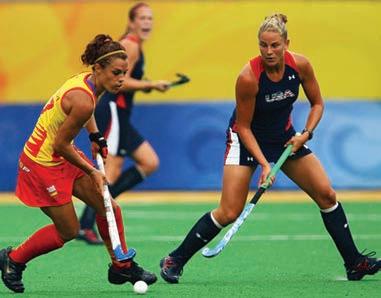
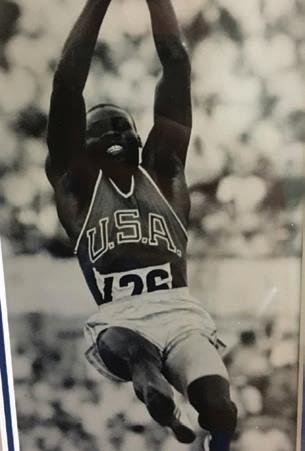
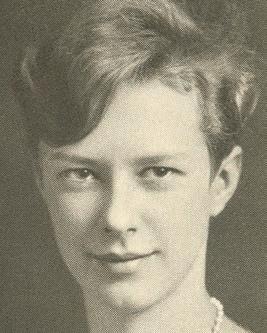
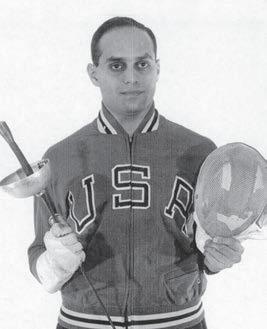
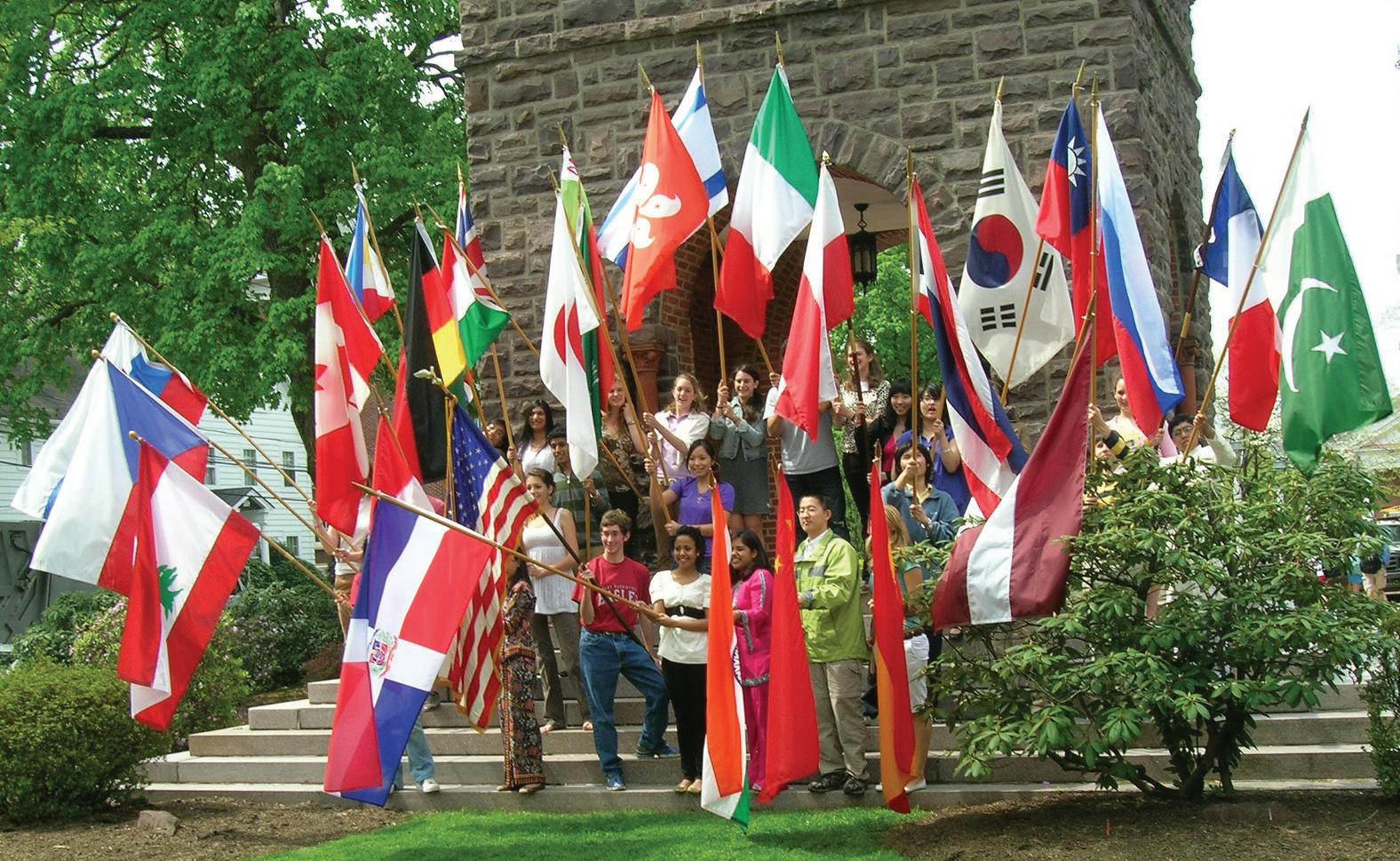
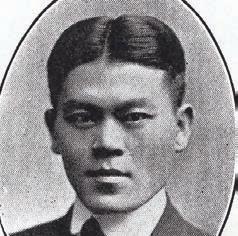
By Jack Eidam
The first known international students at Wyoming Seminary are national heroes, fathers of South Korea’s democratic movement. The legends of Dr. So Jae Pil (Harry Hillman Academy 1889) and DR. CHOUGH PYUNG OK 1918 are well documented in Korean history books. Both were thought-leaders who challenged governmental authorities, leading the way to a free and open South Korea.
KRISTEN KRISTENSEN 1913 of Denmark immigrated with his wooden shoes to attend Sem and eventually became mayor of Yonkers, New York.
It was Cuban native and Sem teacher Pedro Gillott who was responsible for the first continuous stream of international students. Gillott taught at Sem from 1894 until he died in 1930, and through his influence and reputation, many students from varied Latin-American republics studied here.
Following World War II, the American Field Service for several years arranged placement of students from Norway, Finland, Belgium, Czechoslovakia (now the Czech Republic and Slovakia) and Germany. In the 1960s, Sem had an arrangement with the Government of Kuwait through which one boy matriculated annually with expenses fully paid by the Kuwaiti Government.
HITOSHI TAKEI ’64 of Tokyo may not have been the first Japanese student to come our way, but he certainly has

Sem’s forward-looking educators strategically diversified the mix of students by building a world-wide network of alumni, educators and counselors who referred admission candidates from diverse Asian and European cultures. Sem’s faculty proactively adjusted the curriculum and the admissions department developed a school community reflecting the world of the future. By the 1990s, more than twenty countries were represented in Sem’s student body.
From 1994 to 1998, Sem hosted the Royal Thai Scholars Orientation Program for 70 brilliant Thai secondary school graduates, and Sem has enrolled at least one postgraduate Thai Scholar annually since the early 1990s.
Today, the international population includes 100 students from more than twenty cultures. The application pool is strong, and the selection process for admission is rigorous, lifting the academic strength and integrity of the Sem community. Enrolled students bring diverse talents that enhance the quality of life in arts, athletics, academics and cultural awareness.
In addition to diversifying the composition of the school community, Sem offers opportunities for students to become immersed in other cultures. Now-retired teacher James Kersey organized several service trips to Malawi in Africa, and many teachers escorted summer-study tours to Europe. John Vaida and his Fine Arts Department faculty organized museum excursions and performance tours; ice hockey, soccer and wresting teams competed in Europe; and the 1984 boys soccer team was the first American secondary school team to compete in China.
Recent initiatives in the international arena greatly enhance the opportunities for Sem students to experience other cultures first hand. Sem President Kevin Rea spearheaded Sem’s entry into Round Square which organizes international conference and service initiatives. To date, Sem students have attended multinational conferences in Germany, South Africa, Canada and Peru.
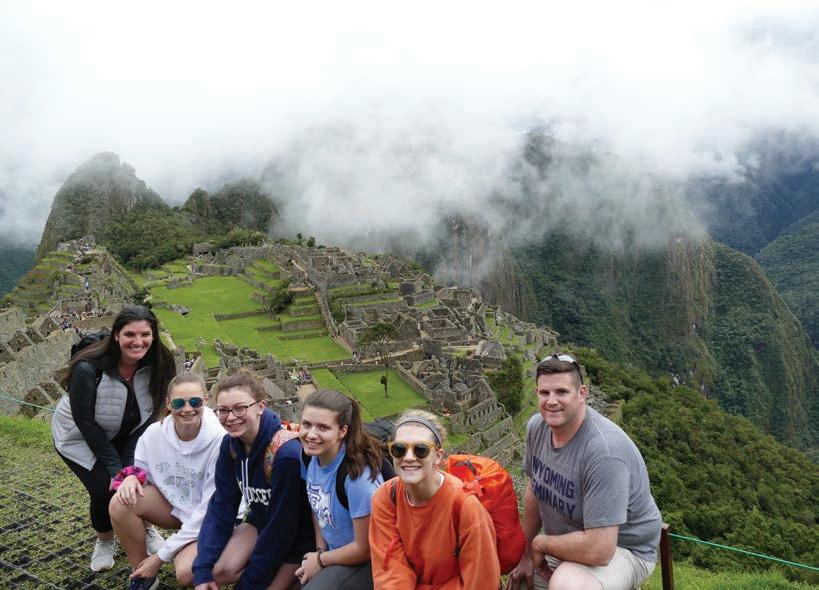

been the most loyal. He is singlehandedly responsible for enabling countless young Japanese students to attend Sem.
The early 1980s brought a wave of new students from other countries. Adolescent Americans living with their families in the oil fields of Saudi Arabia were provided full tuition, room and board by the oil companies to attend boarding schools. The Arabian American Oil Company (ARAMCO) invited selected boarding schools to court ninth-graders, and Sem was among those schools.
As the trend toward globalization deepened, it became clear young people then in our schools would live in a world of international economies, politics and recreational travel.

Sem’s newest initiative, the Project for Enhanced Global Understanding, invites four rising sophomores – two each from Israel and from the West Bank and/or Gaza – to join the student body. Global leadership, peaceful purpose and personal growth are the goals for the students as they explore the issues of the region through very personal experiences.
Living and learning at Wyoming Seminary would be far different were it not for the diversity of its international community and the opportunity for well-informed travel. Multiculturalism opens minds and builds transformative relationships. The divisiveness of bias is reduced, the likelihood of understanding is enhanced and the possibility for peaceful economic and political policies among nations is improved.

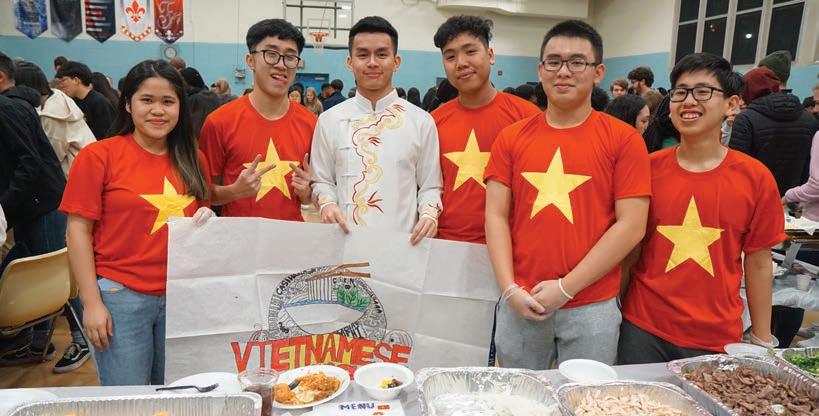
AMphictyon Independent adelphian plattonian
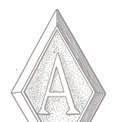

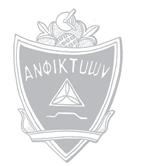
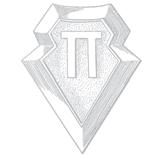
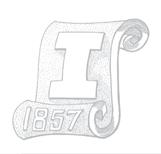
By Liz Hibbard ’69
n 2004, when AMBER SKYE NOYES ’05 arrived on the Upper School campus with her brother TYLER ’05, she expected to continue the legacy of joining the same society her mother KARYN CARPENTER '76 had belonged to. To her surprise, Sem’s Alexandrian, Athenian, Florentine and Oxonian Societies were no longer in existence; they had faded in the early 1990s.
Inspired by her family’s stories of school spirit and fun provided by the societies, Noyes worked throughout her senior year with school administration officials to revitalize the student groups and continue their legacy tradition. By the time she graduated, the Sem community once again could engage in fierce yet friendly competitions to earn points and win the coveted Black Diamond Trophy, in a day-long Society Day event on the last day of school. Fourteen years later, Society Day is a hugely popular event, eagerly anticipated by the student body.
Student activities have been an integral part of Sem from its earliest days, and many fondly-remembered
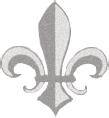
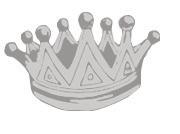




events were the creation of school societies. Before the school’s first year closed in 1845, the first society, the Mathetean Society, had been formed. Within a few years the students created the Wyoming Seminary Lyceum and Alpha Epsilon, for boys, and The Ladies Association, for girls. These groups were designed to be serious and literary in nature and organized lectures, orations, musical performances, declamations and receptions. Later the Amphictyon Association, in 1853, was the first of the “modern” societies to be formed, followed by the Independent Society. In 1865, the girls dropped the Ladies Association and organized the Adelphian Society, followed by the Plattonian Society in 1891. Until 1962, these four societies served, respectively, day boys, boarding boys, day girls and boarding girls.
For more than 100 years the societies organized many student activities such as the Opinator (1883), the Oratorical Contest (1892), and debates, inter-society plays and the Declamation Contest.
In addition, non-society offerings such as the Annual yearbook (founded in 1897 and now called the Wyoming) as well as YMCA and YWCA organizations
Alexandrian | Athenian | Florentine Oxonian

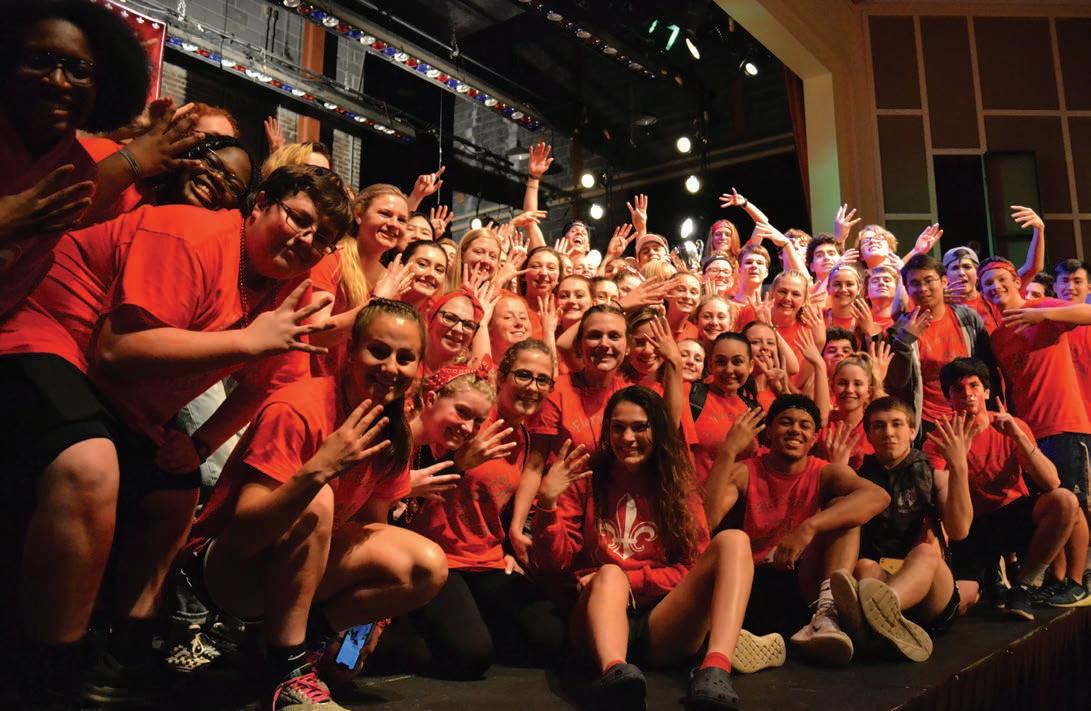
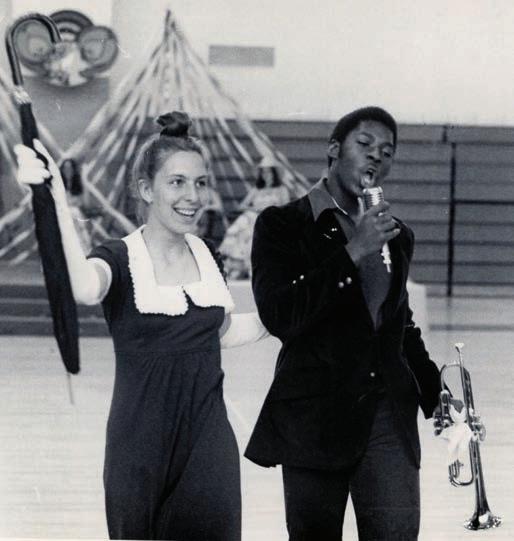
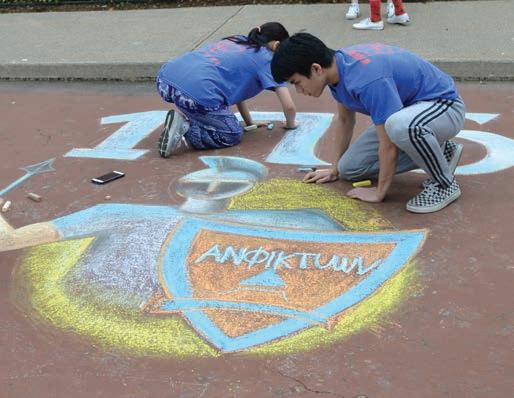
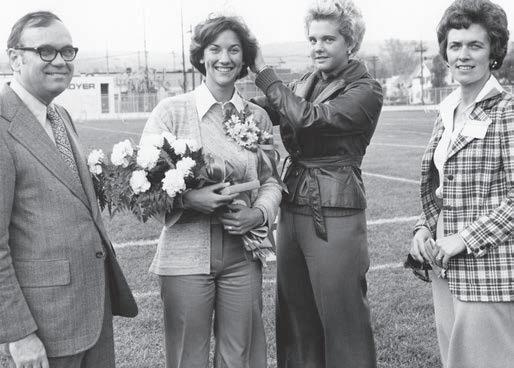

became available. In the first half of the 20th century, May Day and its Queen became an annual tradition. Formal dances, including the Sweetheart’s Ball, were held at least twice each year in the Pettebone Gym. While the societies organized the weekly Saturday Blue and White Dances, the annual Prom grew in popularity; a semi-formal dance and formal dance continue today to be held each year off campus.
Glance through most any Wyoming Seminary yearbook, and you’ll see evocative photos of club activities such as the Model Railroad Club, Drama and Chess Club, the Gong Show, Senior Skip Day, the Pep Band, Science Club and Art Club. Homecoming in particular was a huge fall event, replete with pep rallies, bonfires, and Society float and Homecoming Queen competitions.
In the early 1960s, as school spirit waned, the Student-Faculty Council reconsidered the society structure and decided the original societies needed to be recreated. In 1962 the new societies, named Alexandrian, Athenian, Florentine and Oxonian for the four chief centers of western civilization, were formed.
These new groups took over the former society competitions and added the Sem Bowl and Homecoming contests. In the 1990s, as the number of clubs, sports and other activities increased, the societies once again disappeared. Thanks to Amber Noyes, they have returned better than ever.
Today’s Sem student activities scene includes more than 46 clubs, many of which reflect the nation’s current climate: SOCA (Students of Color Association), Coding Club, Fellowship of Christian Athletes, Mock Trial and Model United Nations, Science Research Group, Mandarin Club and International Club, Science Olympiad, Community Service Committee and many, many more. Student Government, Peer Group, Library Advisory Board, Academic Department Representatives and other leadership opportunities round out a deep selection of activities for Sem students to choose from. The Opinator and the Wyoming continue the Sem tradition of chronicling the life of the Sem community.
Woven through all of these is the Sem society tradition thread; first brought to life in 1845, and continuing today to enhance the life of the school community.
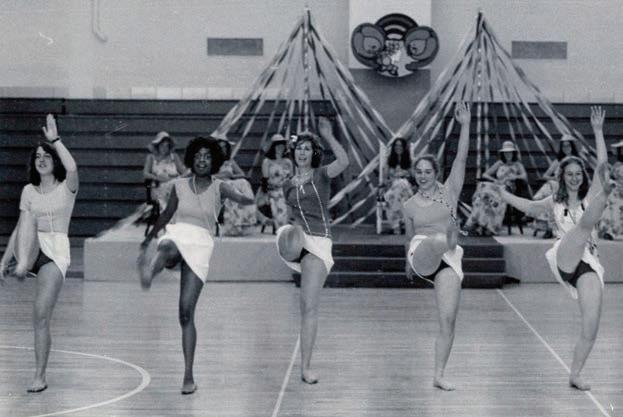
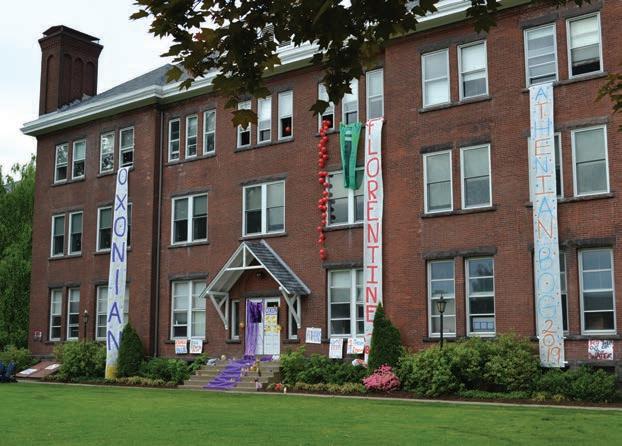

By John Shafer ’71
From breaker boy to a president of a remarkable college prep school — that is the path that the late Rev. Harold C. Buckingham, D.D. took. Buckingham had to leave school in 1908 at age 14 to help support his family by working in the mining industry. Seven years later, he was one of the many young people that Wyoming Seminary’s fourth president Dr. Levi Sprague brought to Sem on a scholarship. He went on to graduate in 1919, was ordained a Methodist minister and later served as Sem’s eighth president, beginning in 1966. He is one of many, many young men and women who, through the generosity of Sem’s Trustees, donors and alumni, went on to serve their communities and the nation with distinction.
In 1844, something remarkable happened in Kingston. In this unlikely place, leaders of the Methodist Church established a place of teaching and learning for 17 boys and 14 girls.
It was a momentous decision. In this small school, students and their teachers formed a community that allowed and demanded individual growth, for talents and strengths of many sorts were needed to keep the community vital. By necessity, Wyoming Seminary developed the capacity to stretch, reach and accomplish large things.
To sustain a well-rounded and energetic community, Wyoming Seminary must continue to enroll scholars, performers, leaders, athletes, students from many backgrounds and places. Not all can afford our costs, and Sem is not able to meet the full need of every qualified student who
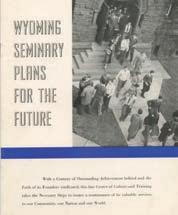
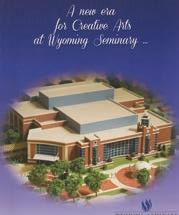
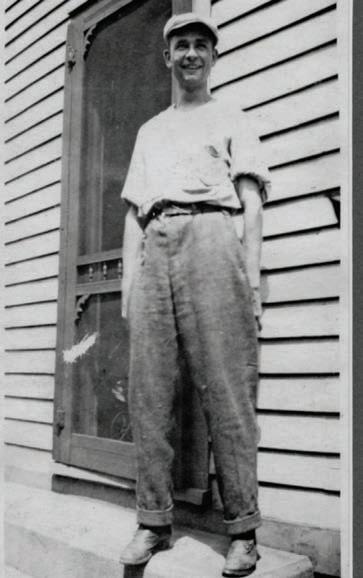
from across the street and around the world.
It is remarkable that an educational institution that is celebrating its 175th birthday has had only 12 individuals serve as its president. That statistic is even more amazing when you realize that two of those presidents served for only one year each!
As blessed as the school has been with the professionals who have run the institution, it has been the trustees and other volunteer leaders who have truly led by example. And they have led right from the school’s inception. When needs arose, those trustees who had supported and nurtured the school with their acumen and expertise through the years also acted on their own charitable philanthropic impulses and feelings. Time and time again throughout Sem’s history, key volunteer leaders have stepped forward and helped meet crucial physical plant needs or fund an important endowment project. (See sidebar for a description of some of these significant leaders.)
gains admission. We must ensure that the best and brightest students are not denied a Sem education because we cannot help them meet our costs.
It has always been that way. The school’s first president, Reuben Nelson, was adept at spotting youth with genuine ambition, even when the School was busily holding off creditors. President Levi Sprague was well known for going to the mines and asking the foreman for the best and brightest of the breaker boys (such as Hal Buckingham) and then finding the financial resources to make a Sem education possible for that young man. Today, Sem awards more than $9.2 million to students in grades toddler through postgraduate,
By what we give and what we do, we become architects of the school’s future
Through the generosity of these leaders and many other alumni and friends of Sem, the market value of Sem’s endowment has grown from $18 million in June 1994, at the time of the institution’s 150th Anniversary, to $69.5 million as the school celebrates its 175th Anniversary.
Leadership across the generations of Wyoming Seminary testifies to the wisdom of an education that values the whole person. In its 175 years, Sem has never been stronger than it is today, but it must be stronger still to meet the expectations our accomplishments have created. By what we give and what we do, we become architects of the school’s future.

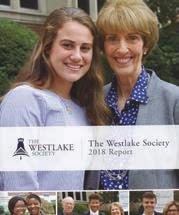
WILLIAM SWETLAND AND JUDGE ZIBA BENNETT: In 1850, pledged funds to build a new school building and library
DORIS PATRICK: Funded construction of the Buckingham Performing Arts Center and created the Doris Patrick Endowed Teaching Chair in her estate
NESBITT FAMILY: Contributed funds for the construction of Nesbitt Science Hall and Nesbitt Stadium
DARTE-DICKSON-DARLING FAMILY: Descendants of William Swetland funded the Pettebone-Dickson Gymnasium and Student Center; funded purchase of Nesbitt estate on Maple Avenue, Kingston
LEA HUNT: Through her estate, she funded the first major endowed scholarship in Sem’s history
WALTER CARPENTER: Long-term Trustee funded Carpenter Hall, Carpenter Athletic Center and the faculty retirement program; provided a $1 million bequest
DR. JOSEPH DONCHESS: his bequest provided $6 million to the school’s endowment
F.M. KIRBY: In 1929, he gave Sem 1,000 shares of the F.W. Woolworth Company — worth $100,000 at that time — to the school’s endowment
F.M. KIRBY FOUNDATION: Funded the Kirby Library at Upper School; gifts for school building projects and the lead gift of $7.5 million to help build the Allan P. and Marian Sutherland Kirby Center for Creative Arts



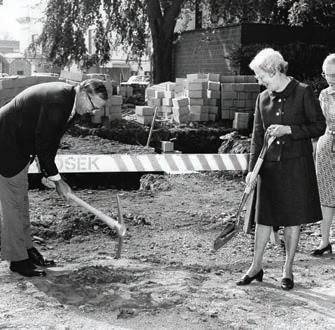
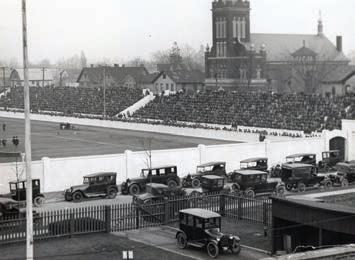

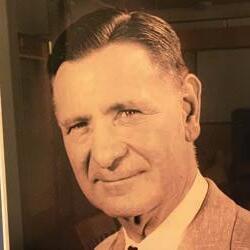


201 North Sprague Avenue
Kingston, PA 18704-3593
Address service requested
Notice: Postal regulations require the school to pay a fee for every copy not deliverable as addressed. Please notify us of any change of address, giving both the old and new addresses. You may email changes to alumni@wyomingseminary.org.
